The digital product market is exploding right now - and trust us, we’d know. Creators on Whop have already sold over $1 billion worth of them.
But what makes digital products so popular?
Well, they're low-effort, high-reward. Create something once, sell it over and over again. No stocking out, no shipping delays, and no painful supply chain issues in sight.
Everyone’s getting in on it, and for good reason. The market’s on track to hit $15 billion by 2027, and there's still plenty of room to grow.
If you're wondering what to sell in 2025, you're in the right place.
We’re breaking down the best digital products to sell this year, and how to start building your own today.
Let’s get into it.
🏆 The best digital products to sell online
1. Membership sites

Memberships are a great way to build a community around your brand. They provide an exclusive feel and often deliver premium services or perks to paying members.
What your membership includes will depend on your brand and audience. You could offer access to a schedule of relevant online talks, digital coworking sessions, or video coaching in exchange for a monthly fee. With Whop you can easily create your own whop as a membership site.
How easy is it? Medium: easy to start, needs dedication to grow
How much does it cost to start? Nothing with Whop
How much can you earn? Unlimited earning potential
2. Online courses
Don't have the time to run an online community? No problem. Get paid for sharing your knowledge with an online course. The parameters are broad; you can build a course for online traders, show freelancers how to land clients or share your experience going viral on social media.
The best part is, that once you’ve created the building blocks of your online course, you can sell it to hundreds of thousands of students. Just remember to update it regularly to ensure students are getting the best bang for their buck.
How easy is it? Very easy when you use AI and course builders (like the builder in Whop) to generate your course
How much does it cost to start? $0 with Whop
How much can you earn? Anywhere from $50-$5000+ per course sold
- How to create an online course to sell
- How to create and sell courses on Whop
- 200+ online course ideas across all niches
3. Ebooks

If you don’t fancy creating an online course, why not share your knowledge in an ebook format?
Once you’ve written your content, you can publish it on sites like Whop, Amazon, and other digital platforms to increase your reach. Again, once you’ve put in the effort upfront, you can continue to reap the rewards long after you’ve published your ebook.
How easy is it? Write your ebook with AI and it can be created in less than one day
How much does it cost to start? $0 with platforms like ChatGPT, Canva, and Whop
How much can you earn? $5-100 per ebook sale
4. Prints
If you’ve got a creative streak and enjoy drawing or painting, you can turn your masterpieces into sellable prints. There are print-on-demand platforms you can upload your artwork to and have it transferred onto mugs, t-shirts, notebooks, and other physical products — or you can simply sell it as a wall print.
How easy is it? If you're reselling existing designs or using AI, easy. If making your own designs, some skill is required
How much does it cost to start? $0 with print-on-demand platforms or digital print sales
How much can you earn? A modest amount, typically $3-$300 per print
- Our list of the best print on demand products to sell
- How to make printables to sell (in 8 simple steps)
5. Planners and journals
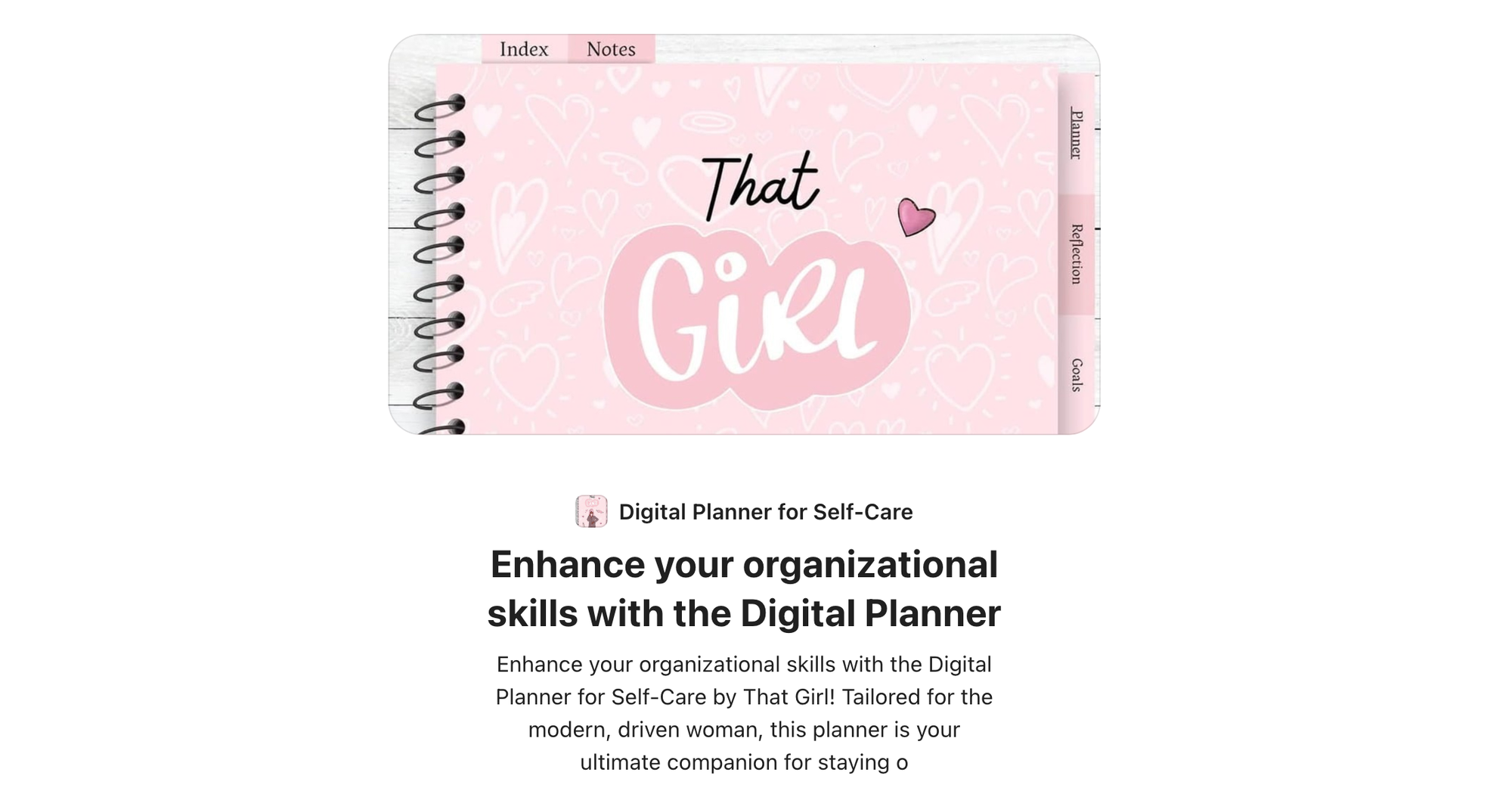
Help people stay organized by selling online or printable planners and journals. You can create standard organizers arranged by month and week, or you can sell planners and journals for specific purposes — like journals for small business owners or travel planners.
How easy is it? Easy if reselling PLR planners, medium if making from scratch
How much does it cost to start? From $0 - varies on platforms used
How much can you earn? Modest earnings of $10-50 per planner
6. Subscriptions
Digital subscriptions work similarly to memberships: people pay a monthly fee in exchange for access to a tool or exclusive content.
You’ll most commonly see subscriptions applied to physical products, like coffee, makeup, or snacks, but there’s no reason why you can’t sell a digital subscription for a niche magazine or a monthly recipe program. The video above shows Orangie - a meme coin trader who sells subscriptions to his crypto trading whop.
How easy is it? Easy to get started when you use Whop
How much does it cost to start? $0 to start with Whop
How much can you earn? Wide earning range, with subscriptions anywhere from $10 to over $1000 a month per subscriber
- How to sell subscriptions online
- How to start a subscription business: the secrets to monthly revenue
7. Tutorials
Provide a walkthrough of a complicated topic or a solution to a pain point a specific audience has. Tutorials can come in video format, guides, or interactive content — whatever method best suits your teaching topic.
Similarly to online courses, you can guide buyers through a learning curve, whether it’s how to crochet a frog or make the best cheese sauce.
How easy is it? Easy. All you need is your knowledge and a way to put it into video or text format
How much does it cost to start? $0 with platforms like Canva and Whop
How much can you earn? Depends on the format of the tutorial
8. Stock photos

Are you a natural behind the camera? If friends and family are often asking you to shoot their weddings, birthdays, and baby showers, why not monetize your skill? Stock photo sites like Shutterstock, Unsplash, and Getty Images pay budding photographers each time someone downloads their image.
Some popular image types include:
- Landscape photos
- Flat-lay photos of desk spaces
- City scenes
- Business-related snaps of meetings and offices
- Still-life pics of flowers and objects
How easy is it? Easy - all you need is a camera and computer
How much does it cost to start? From $0
How much can you earn? Typically a low earning potential of a few hundred - to a few thousand - dollars
Find the best way to sell pictures online
9. Stock videos
If you’re better at filming video footage than taking stills, consider selling your scenes on stock video sites. These are becoming increasingly common as people start to experiment more with social videos like Instagram Reels and TikTok.
How easy is it? Easy, you just need recording equipment and a way to upload your videos
How much does it cost to start? From $0
How much can you earn? Typically a low earning potential of a few hundred - to a few thousand - dollars
- Video monetization: How you can make money online with video content
- Best video monetization platforms for content creators
10. Software
Tim Konieczny from Rapidemo
Building a piece of software requires some dedicated upfront effort (and a certain amount of skill and knowledge).
But, once you’ve got your product, you can sell it to as many people as you like. If you’re not particularly tech-savvy, you can learn some easy coding techniques, use a no-code tool to build your software product, or hire someone to help you make the initial product.
How easy is it? Requires some basic understanding of software - made easier with AI
How much does it cost to start? Usually starts at $10k + but can be bootstrapped, especially when using AI
How much can you earn? Huge earning potential with SaaS
11. Spreadsheets
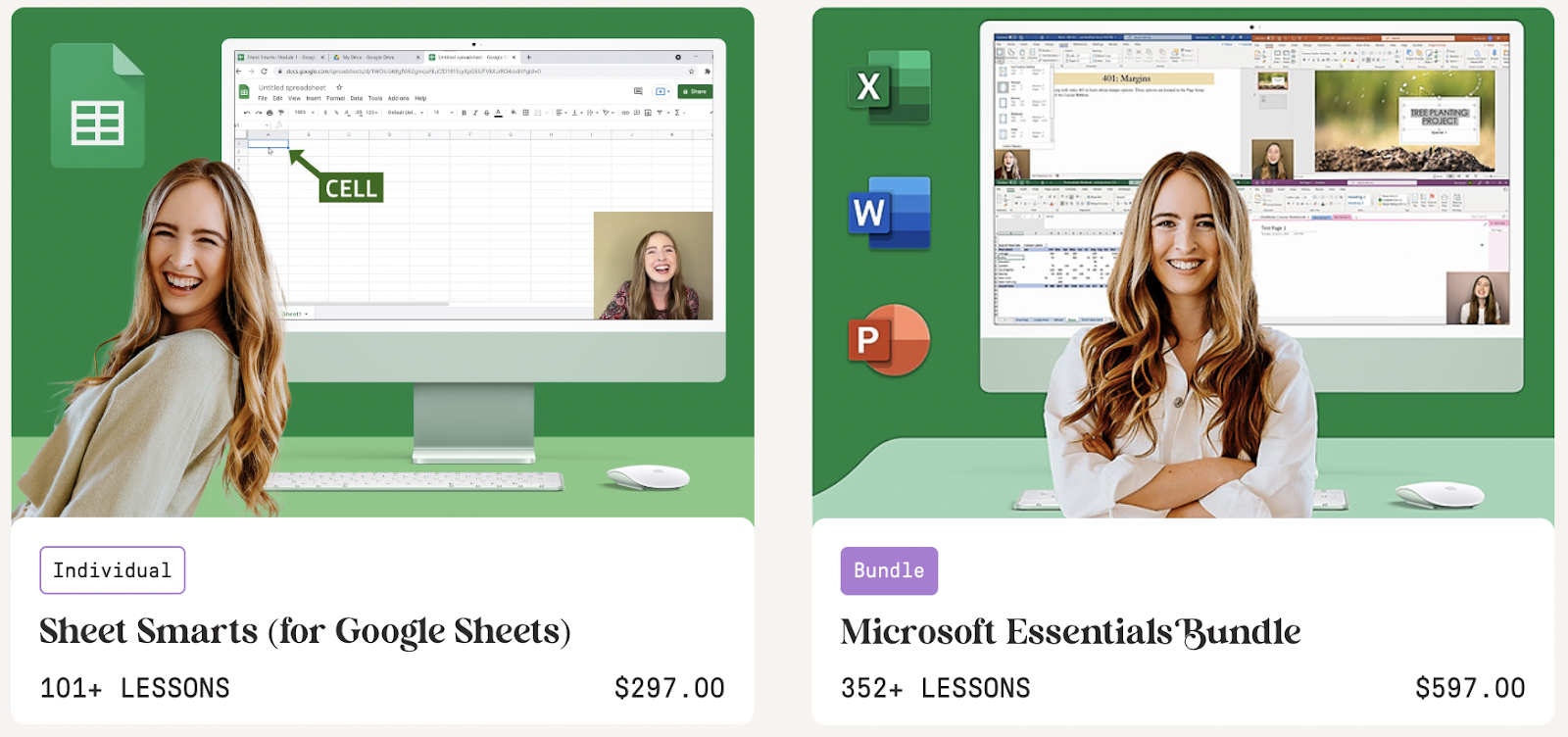
Spreadsheets are a bugbear for a lot of people, but if you’re a whizz at Excel formulas, you can make some money helping people ease the pain by creating spreadsheets for specific industries.
How easy is it? This depends on how easy you find Excel!
How much does it cost to start? From $0 with Whop and an existing Excel subscription
How much can you earn? Mid-level earning potential, with spreadsheets typically selling between $15 and $100 dollars
12. Digital artwork
While print-on-demand websites let you turn your artwork into printable products, you can also sell digital artwork that stays on screen. We’re talking about things like desktop wallpapers, phone backgrounds, and vectors.
How easy is it? Easy for artists, non-artists will need to brush up on their skills
How much does it cost to start? From $0
How much can you earn? Low to mid earning potential as this is a low-cost product
- How to make money as a digital artist
- Skillshare vs Domestika: Platforms for selling creative skills courses
13. Downloadable checklists
Create some digital to-dos around an area of interest or put together a downloadable checklist that helps people complete a specific task.
For example, you might sell a checklist for website essentials, moving house, or a cleaning rota.
How easy is it? Very easy with Canva and AI
How much does it cost to start? $0 - simply use Canva, ChatGPT, and Whop
How much can you earn? Low to mid earnings (but a great passive income earner)
14. Guides and worksheets
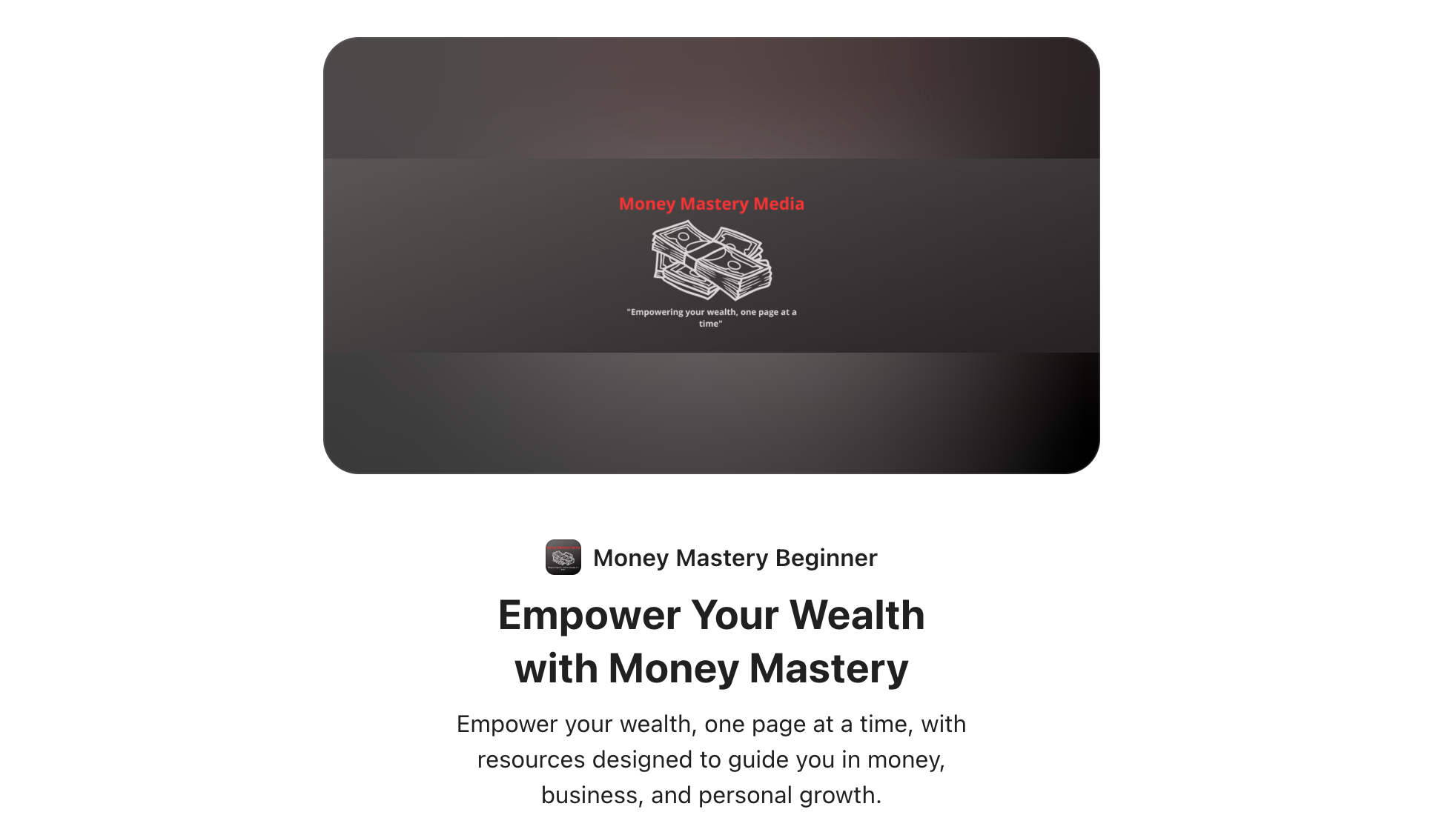
Get hands-on with guides and worksheets. Walk people through a solution or give them a document they can fill out in their own time. Downloadable versions of guides and worksheets can either be used online or printed out and used as a physical copy.
Examples of guides and worksheets include:
- A workbook for discovering and exploring your human design
- A guide to setting up an Instagram profile
- A guide and worksheet for learning about dietary needs
- A guidebook for understanding interior design
How easy is it? Easy! Create a guide or sheet based on your own expertise
How much does it cost to start? $0 with AI, Canva, and Whop
How much can you earn? Low to mid-level earning potential with a typical sales price of $10-200 per worksheet or guide
15. Newsletters
Newsletters are a great way to grow an audience and become an expert on a chosen topic.
There are several ways you can monetize your subscriber count, including running paid ads, partnering with brands, and setting up a paid tier that goes above and beyond the regular content delivered in your newsletter.
How easy is it? Medium-difficulty
How much does it cost to start? From $0, but as your subscriber count increases, so do your costs
How much can you earn? Unlimited earning potential from subscribers, sponsorships, and affiliate marketing
- How to make money with a newsletter (tips from an experienced creator)
- The best online newsletter platforms
16. Online communities
TJR Trades sells access to an online community for traders
Despite the growing remote work trend, plenty of people still crave connection with other humans. Online communities provide a place for people with specialist interests to get together and socialise — even if it is through a screen.
The best part is, that you don’t even have to offer exclusive content like you would in a membership program. Instead, the value is in the connections and the ability to meet other like-minded people.
How easy is it? Easy to start but requires commitment to grow
How much does it cost to start? $0 with Whop
How much can you earn? Unlimited earning potential - some creators on Whop make over $250k per month with online communities
- Check out the best online community platforms
- Mastering community management: How to build and manage a thriving online space
17. Video courses
If you’ve got something to teach and don’t want to create a full-on interactive course, you can sell a video series or a video course. Simply film a lesson or two and upload them to YouTube via a paywall, or use a platform like Whop.
How easy is it? Easy
How much does it cost to start? $0 with Whop
How much can you earn? Mid-level earnings for videos alone, higher earning potential for videos + community access
18. Templates
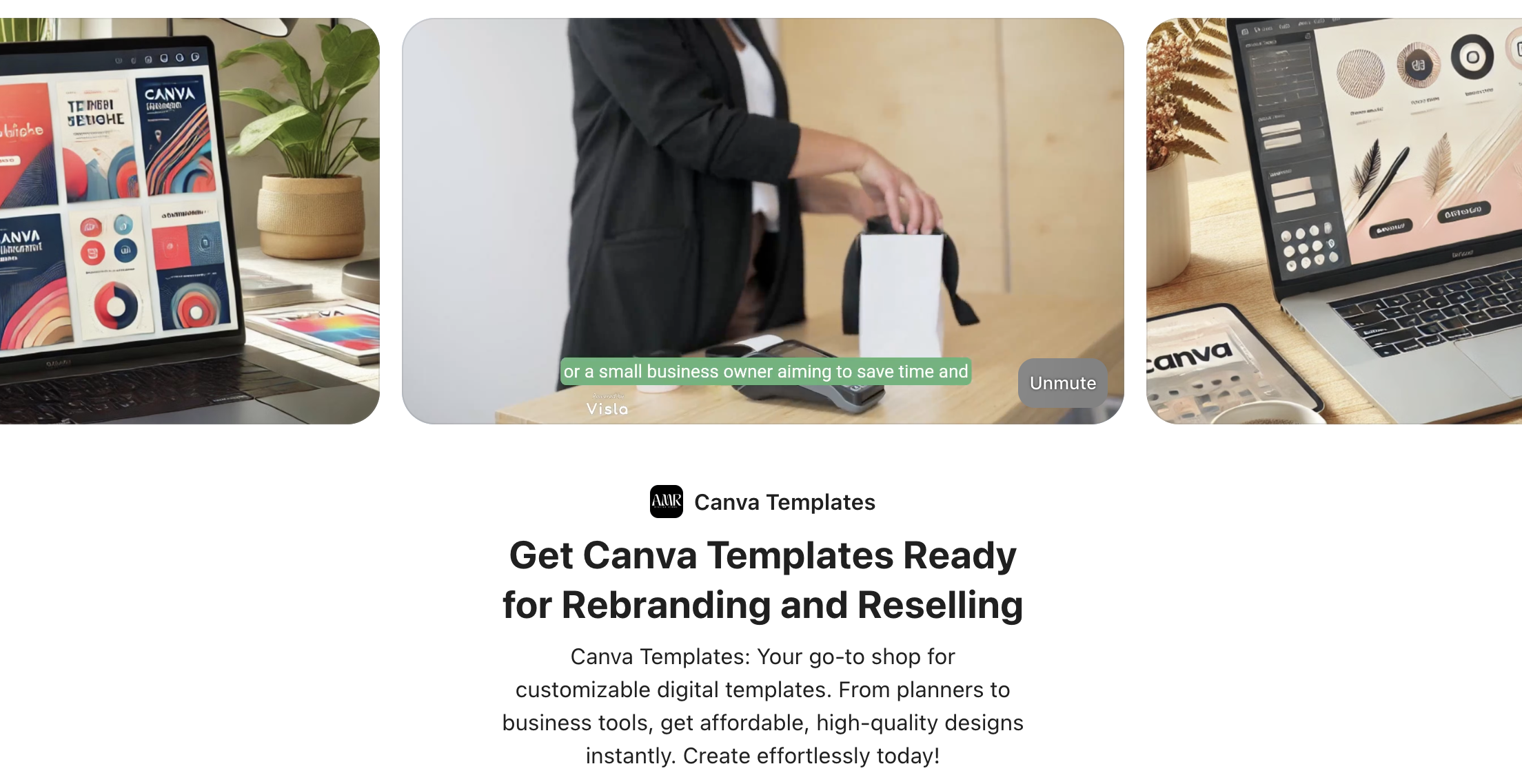
Make people’s lives easier by selling downloadable or digital templates. There are so many ways you can present these — for example, lots of creators have jumped on the Notion bandwagon to create templates for different audience segments.
How easy is it? Very easy with Canva
How much does it cost to start? $0 with Canva and Whop
How much can you earn? Low to mid level earnings, typically $10-$80 per template
19. Calendars and trackers
Similarly to planners and journals, calendars and trackers help people stick to a routine or plan a specific task they need to do.
You might create a tracker for journalists to help them pitch publications or a workout calendar for people looking to get healthier in the New Year.
How easy is it? Easy to medium level difficulty, depending on your level of experience with the tracker you are creating
How much does it cost to start? From $0
How much can you earn? Low to mid level earnings - typically $15-$250 per tracker
20. Fonts
Create fun text styles and unique fonts for your audience. Sites like 1000 Fonts and DaFonts have a bank of browsable fonts that people can download either for free or for a fee.
Licensing your font can be big business, especially if your font becomes popular or gets used by a large company with high volumes of visitors.
How easy is it? Medium-level difficulty, best suited to existing designers
How much does it cost to start? From $0
How much can you earn? Average cost of a font is $30
21. Social media templates
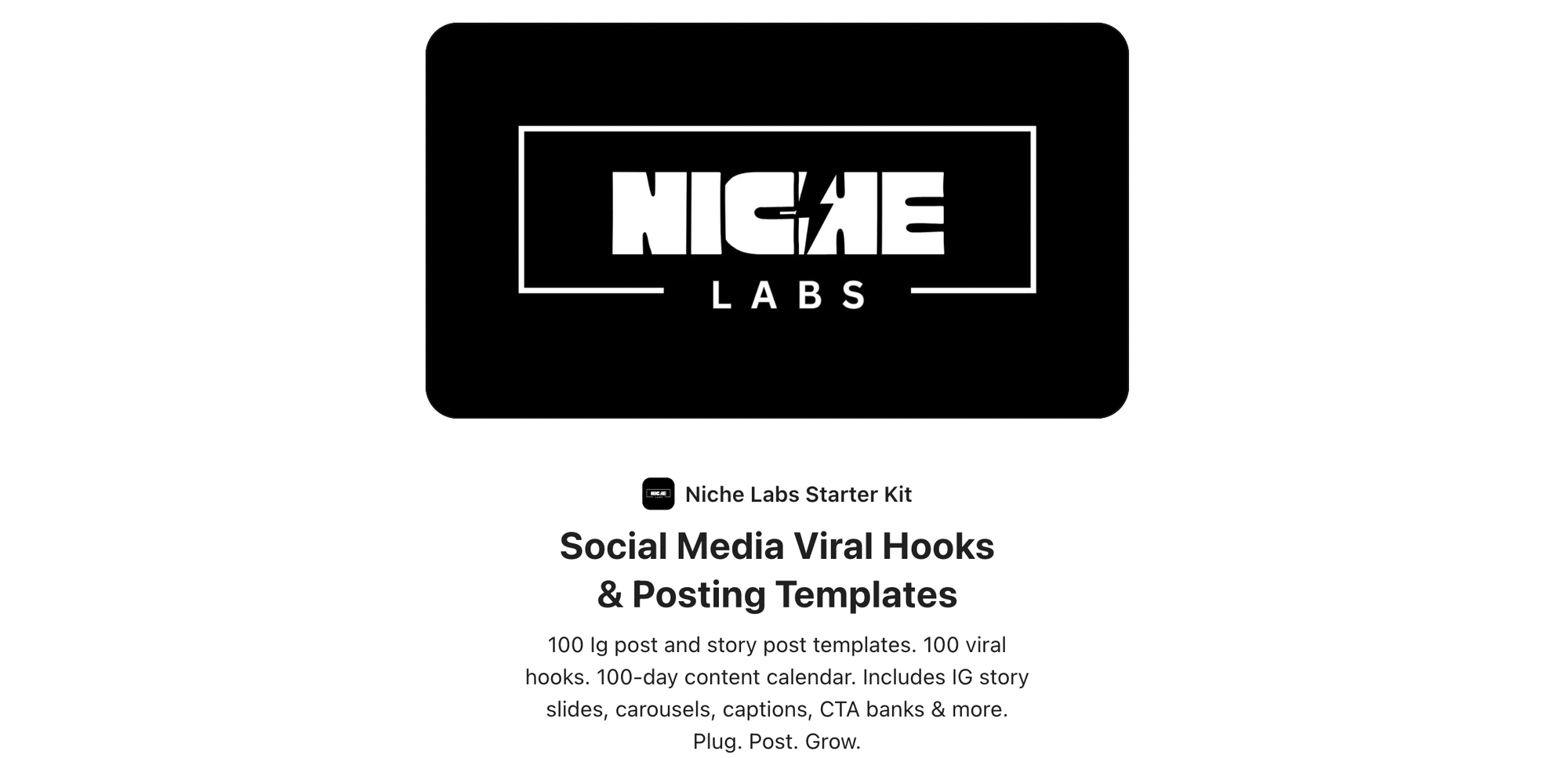
Lots of people DIY their social media graphics which is harder than it looks. If you’ve got a good eye, you can create and sell templates for Instagram images, Stories, and Reels.
Your audience can download the templates and fill them out with their own information.
How easy is it? Easy - especially with AI
How much does it cost to start? From $0 with - you guessed it - AI, Canva, and Whop
How much can you earn? Mid-level earnings, with templates selling from $10-$500 per pack
22. Icon sets
Icons are stylised graphics that people can use on their websites, social media, and landing pages. They can either work as clickable buttons or simply be a decorative addition to a webpage.
Sites like Iconmonstr and Iconfinder have libraries of icons users can browse and you can charge a fee for people to download yours.
How easy is it? Easy to do with software, or, you can draw your own
How much does it cost to start? From $0
How much can you earn? Low to mid earnings, from $10-$250 per set
23. Pre-made website templates
Not everyone is a dab hand with design and putting together a website is an arduous task. Sell pre-made website templates to people who want to DIY their websites without having to do the design work themselves.
You can upload your templates to website theme marketplaces like ThemeForest and Creative Market and sell them for a one-off fee. There is additional money to be made if your theme is good enough to charge a subscription fee for.
How easy is it? Medium-level difficulty
How much does it cost to start? From $0
How much can you earn? Low to mid earning potential
24. Apps
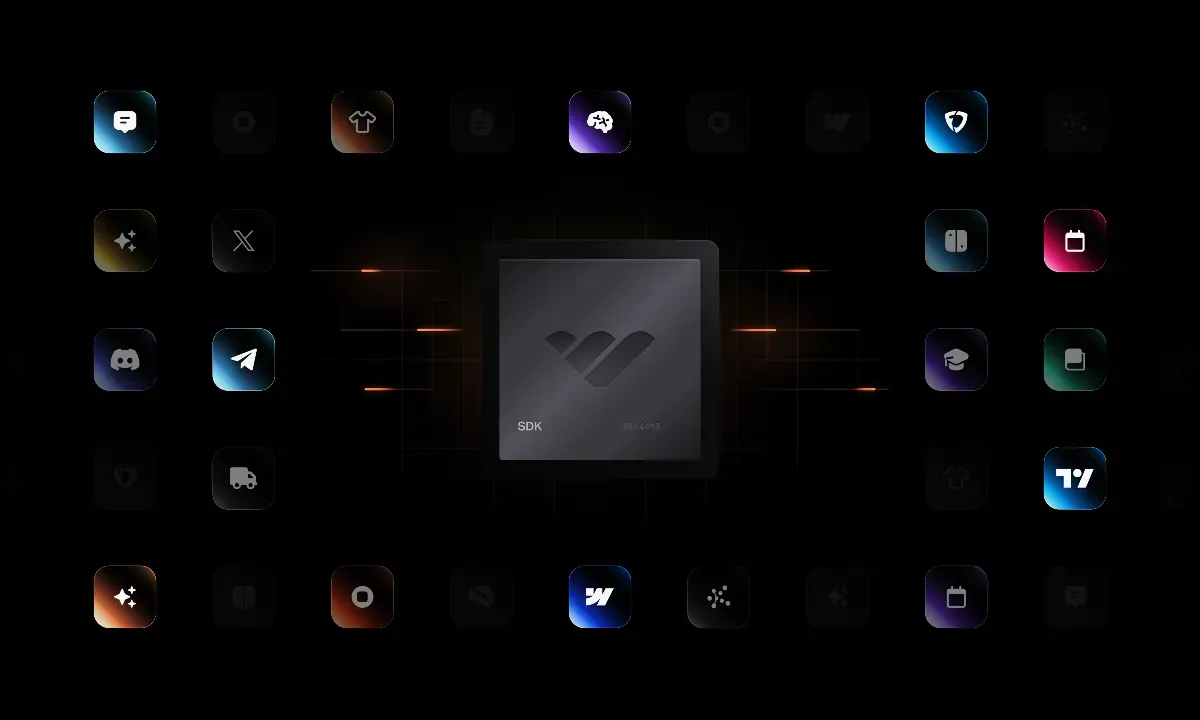
Everyone uses apps these days, whether it’s for organizing their schedule or listening to music. Create an app for a specific target audience and sell it in the App Store. You can add a paid plan to generate passive income or charge for in-app purchases.
Browse the Apple App Store or Google Play to get potential business ideas.
How easy is it? You can use no-code app-builders, but there is a learning curve
How much does it cost to start? Can vary from tens to tens of thousands of dollars
How much can you earn? Huge earning potential
25. WordPress plugins
WordPress plugins help users customize their websites and add features without needing to know complex coding languages.
If you do have coding knowledge (or have someone to help), you can create plugins and sell them via the WordPress plugin marketplace or your own website.
How easy is it? Medium-level difficulty, best suited to coders
How much does it cost to start? From $0
How much can you earn? Mid to high-level earnings - with a potential for huge profit
26. Video games
Similarly to apps, you can create a video game series for people to play on their phones or computers. You can monetize it via a subscription service, in-app purchases, or a one-off download fee.
How easy is it? Medium to hard difficulty level
How much does it cost to start? There's a huge variation, from $500 up to hundreds of millions of dollars
How much can you earn? Unlimited earning potential, but it varies widely based on the type of game you produce
27. Masterclasses

If you’ve run in-person workshops or masterclasses, a really easy way to make them work harder for you is to sell the recording online. Alternatively, you can create a fresh masterclass from scratch — once it’s recorded and uploaded, you can sell it over and over again.
Platforms like Whop make it easy to create and seller a masterclass without needing to create a website or get your head around complex design aesthetics.
How easy is it? Easy - as long as you have the knowledge
How much does it cost to start? From $0
How much can you earn? Mid to high earnings here, as some masterminds can be sold for thousands of dollars
- Everything you need to know about masterminds
- How to run a mastermind session on Whop
- How to use the Masterminds app on Whop
28. Email courses
Land directly in people’s inboxes with an email course spread out over days or weeks. This keeps you front of mind and you can use the emails to upsell other digital products.
You can keep it simple here. Ask for a one-time fee in exchange for the course or offer a monthly plan where people pay a rolling fee for fresh course content each month. Using Whop you can create your whop and send your forum posts to email - meaning your readers get their course directly in their inbox and can then access the course in your whop.
How easy is it? Easy to create, but can be difficult to gain traction at first
How much does it cost to start? From $0, but costs increase as subscribers increase (on some platforms)
How much can you earn? Mid-level earnings
29. Photoshop brushes
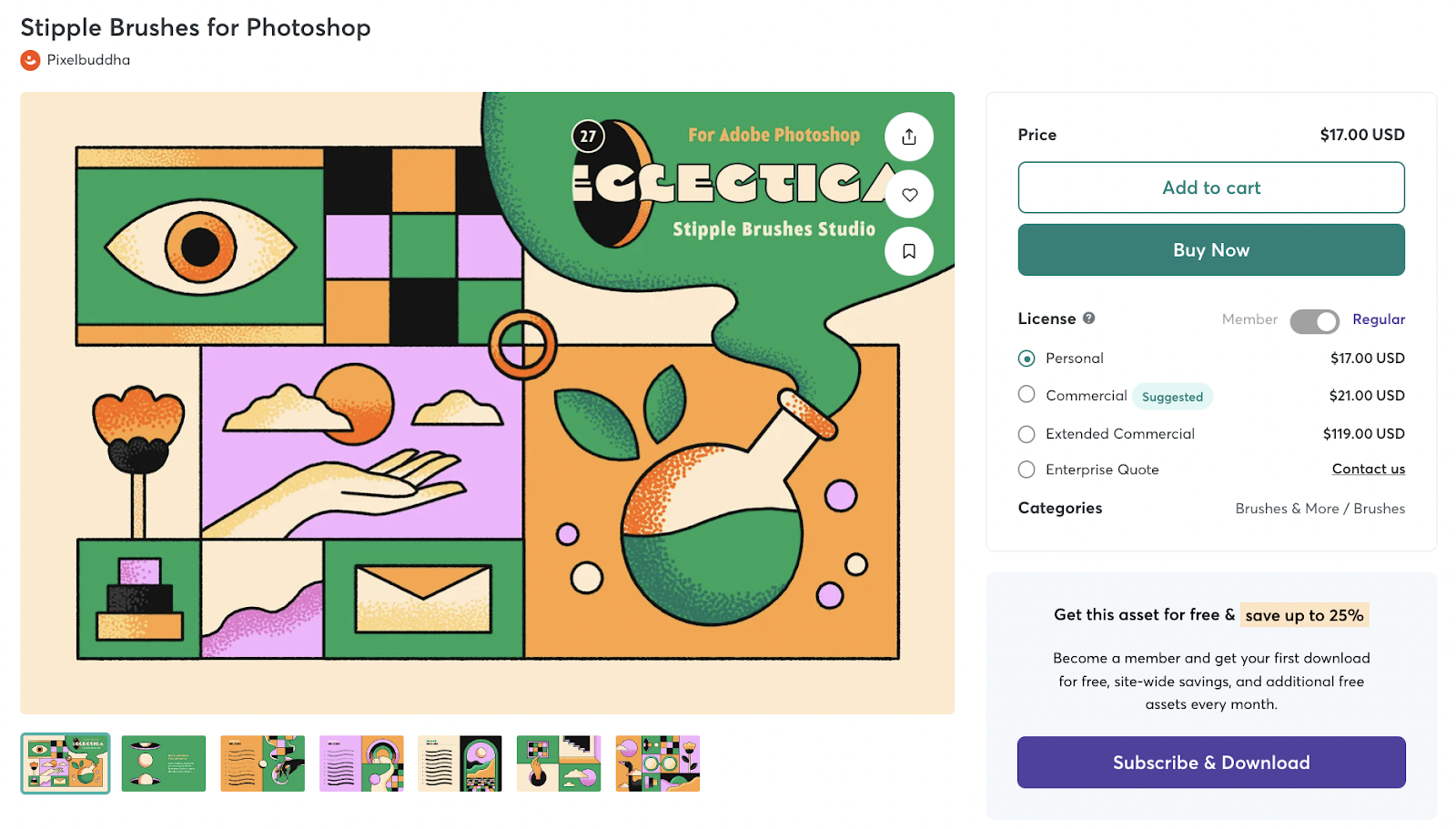
Photoshop brushes help users create unique designs and add their own mark to the photo editing process. Create downloadable brushes that people can add to Photoshop and charge a one-off fee or tiered package prices for multiple brushes at once.
How easy is it? Difficult - you need to already have experience
How much does it cost to start? From $0
How much can you earn? Low to mid level earning potential here, with brushes selling from $5 to $150
30. Printable coloring sheets
Turn your artwork and patterns into coloring sheets for adults or children. You can charge a one-off fee for an instant printable download, or you can turn it into a subscription service that delivers fresh coloring sheets every month.
How easy is it? Easy, especially with PLR products and Canva
How much does it cost to start? From $0
How much can you earn? Low earnings here, with most coloring sheets selling for under $10
31. Audiobooks
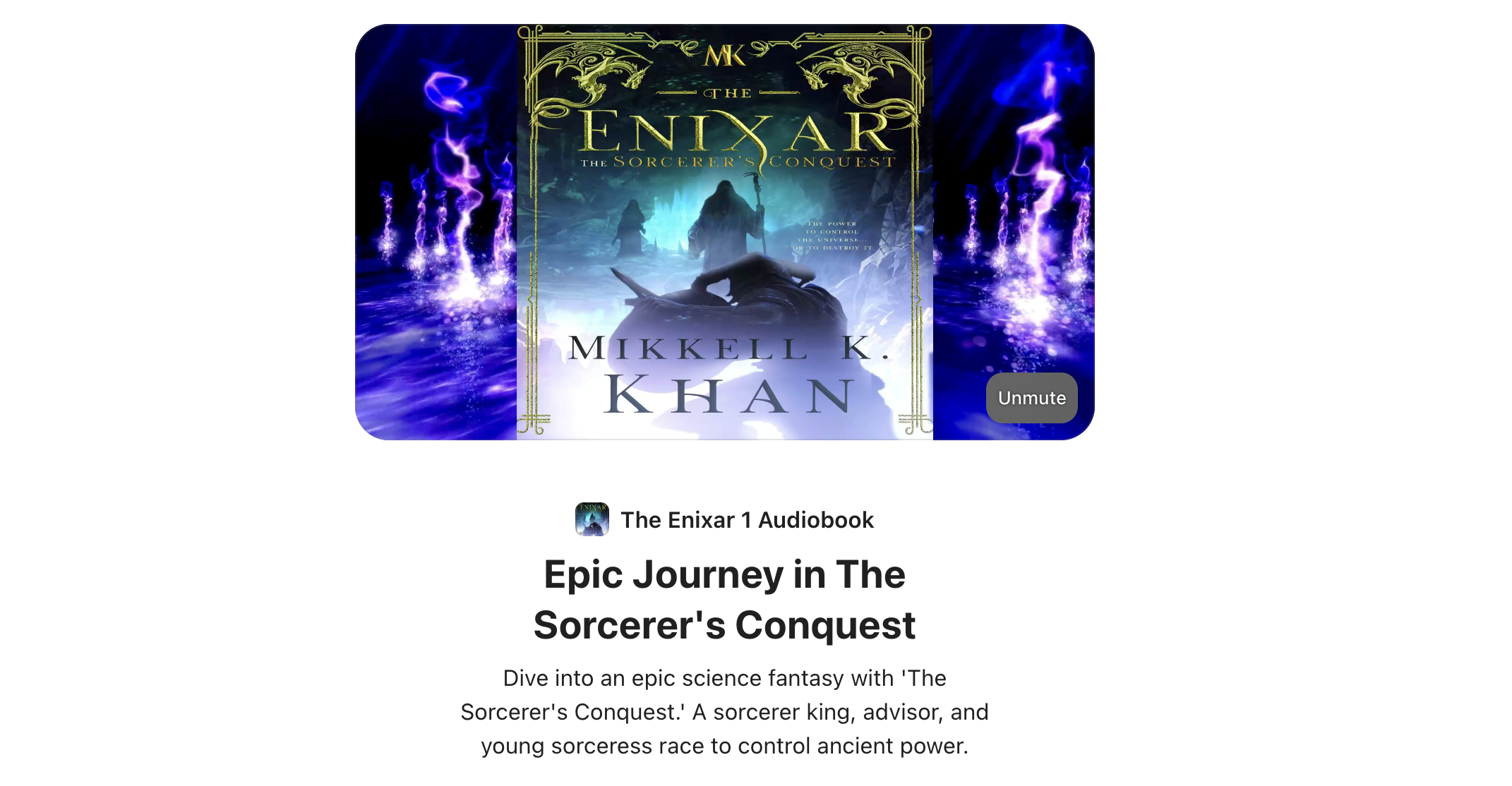
If you’d rather talk about your knowledge than write about it, turn your hand to creating audiobooks. You can write a short story (for kids or adults) and record yourself reading it to sell to customers.
This can work particularly well for children’s books or relaxing content that can be consumed before bedtime. You can even sell audiobooks on Whop!
How easy is it? Easy using AIs like ChatGPT to write and ElevenLabs to voice
How much does it cost to start? From $0 (you might need to subscribe to AIs as you scale)
How much can you earn? Ranging from $10 to $50 based on the length and content of your audiobook
32. Printable games
Keep kids and parents happy by creating printable paper games for the whole family. We’re talking about things like crosswords, word searches, or activity books.
Again, you can charge a one-off fee per game, or you can create a subscription where customers can download new games each month.
How easy is it? Relatively easy using AI to create the game (and its logic) and tools like Photoshop or Canva to create the paper
How much does it cost to start? You can use free tools to create printable games, so $0
How much can you earn? Printable games sell for relatively cheaper prices ranging from a few bucks to $20
33. Songs and licensed music
If you’re a keen lyricist or songwriter and want to get paid for your creativity, consider selling your songs online.
When you license your tracks, people pay a fee to use them in films, videos, and social media, giving you passive income every time someone chooses your song (plus, it gives your music more exposure… who knows, you might catch the attention of a label).
How easy is it? Hard - composing music is a hard skill to learn and master
How much does it cost to start? You'll need software to compose (like Ableton, which starts from $99) and possibly composing equipment which can range from a couple hundred to thousands of bucks
How much can you earn? Songs and licensed music can be sold for up to thousands of dollars based on your client and the quality of your work
34. Content libraries
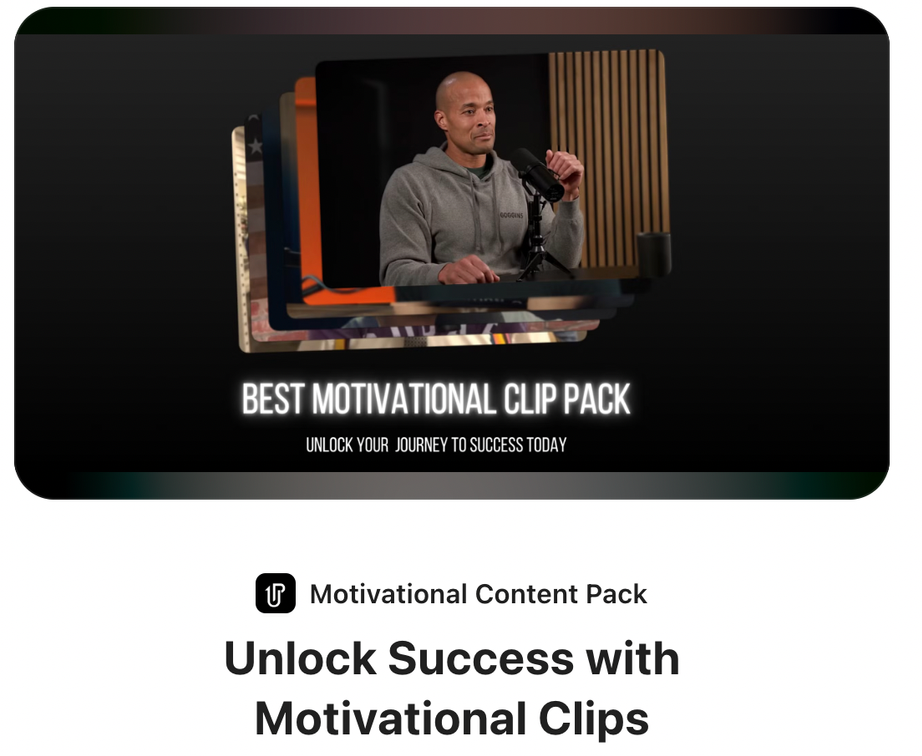
It can be disheartening to create a piece of content and watch it gather dust. Instead of leaving your videos, blog posts, and guides to decay online, combine them in a content library (often known as a content vault).
People can then pay a one-off fee (or a monthly subscription) to access the content.
How easy is it? Easy, all you have to do is to create lists of content you find interesting or helpful
How much does it cost to start? From $0 using platforms like Whop to create the list and sell access to it
How much can you earn? Based on the content quality and length of your list, you can sell them for $1 to $30 dollars
35. Augmented reality filters or overlays
If you’re tech-minded, try your hand at creating augmented reality filters or overlays. Filters can be used on social media (the Snapchat heyday might have passed, but other channels still offer users the chance to augment their surroundings).
Alternatively, augmented reality overlays can help consumers envision what a new sofa might look like in their living room or how a summer dress looks on them.
How easy is it? Medium if you're creating simple filters with static visuals, hard if you're creating interactive mechanics (possibly with 3D objects)
How much does it cost to start? From $0 with free software like TikTok Effect House, to a few hundred bucks with paid software like WebAR
How much can you earn? Based on the complexity of your filters and who you create the filter for, you can sell them for hundreds of dollars
36. Virtual reality experiences or environments
Sometimes people just want to escape—and you can help them with a virtual reality experience. Creating VR “scenes” or experiences can differentiate you from the regular crowd of stock photo and video sellers because you’re offering something new and exciting.
How easy is it? Hard - creating virtual reality experiences is a challenging task. You'll need skills like 3D modelling and scripting
How much does it cost to start? From $0 with free software like Blender
How much can you earn? Interactive virtual reality experiences can sell for hundreds to thousands of dollars while static ones can sell for $30 to $100
37. Interactive fiction or choose-your-own-adventure stories

If you enjoy writing and love weaving a good plot, you can create and sell interactive fiction. It’s the perfect digital product for today’s Netflix-and-chill crowd who want to binge of stories but also feel like they’re in the driver’s seat.
Plus, once you’ve built your story structure, you can sell it again and again with very little effort on your part.
How easy is it? Easy using AIs like ChatGPT, medium if you're planning to write it yourself
How much does it cost to start? From $0 - the free version of ChatGPT is more than capable of handling storytelling
How much can you earn? Depending on the length and content of your story, you can sell them for $10 to $20
38. Custom AI chatbots for specific niches
Many businesses are turning to AI-powered chatbots to deliver customer support when their human teams are offline. But it can be tricky to configure a chatbot from scratch so it sends the right answers and actually helps—not hinders—the shopping experience.
Try configuring AI chatbot templates for different niches. For example, you might create a chatbot perfect for companies selling vegan chocolate or one that helps finance companies send clients to the right resources.
How easy is it? Medium - chatbot wrappers can be easily made but they will need configuration, training, and integration into your client's platform
How much does it cost to start? From $0 - all you need are coding and web development skills
How much can you earn? Depending on how secure and trained your chatbot is, you can sell them for $100 to $1.000+ (for custom trained models)
Check out these examples of the best AI chatbots for ecommerce
39. Digital escape rooms or puzzle experiences
Why not create a virtual playground where people can flex their gray matter and feel like Sherlock Holmes? Escape rooms are a popular way for people to pass the time, enjoy an evening with friends, or provide a bonding experience for remote teams outside of awkward Zoom happy hours.
Once you’ve built your digital brain teaser, you can sell it as many times as you like without restocking shelves.
How easy is it? Easy using AI to write the story/logic and to create the visuals
How much does it cost to start? From $0 to $10 (for MidJourney subscription)
How much can you earn? From $5 to $30 depending on the complexity of your product
40. Job boards
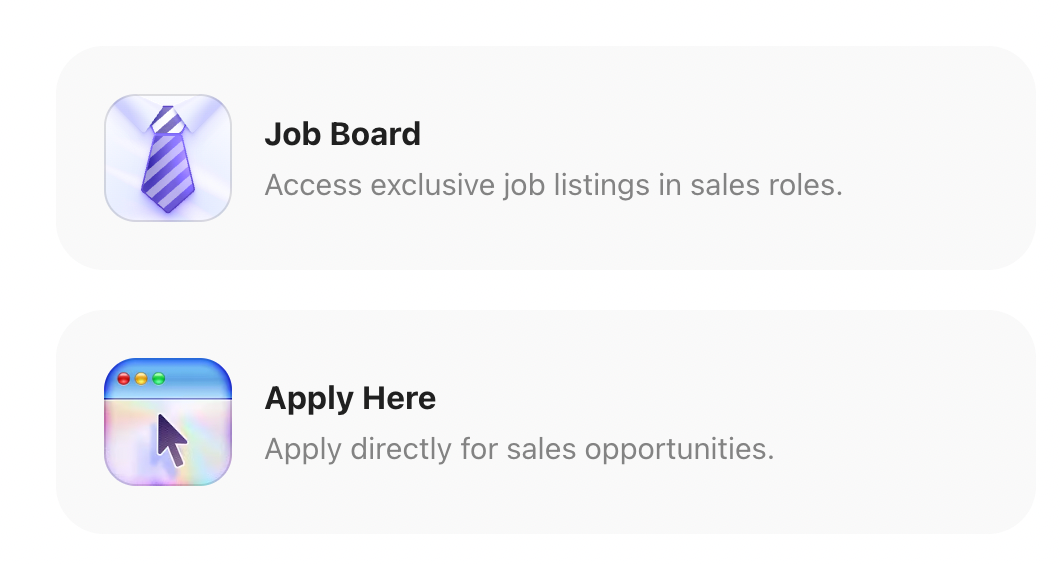
Pull together recent job openings and list them all in one central place. Make it easy for people to find opportunities that are a good fit with niche filters and the ability to save relevant openings. Once you’ve set up the tech behind the job board, you can use automation capabilities to make sure it pulls in fresh opportunities every day.
With Whop, you can create a job board in your very own whop.
How easy is it? Easy but might take time
How much does it cost to start? From $0 - you can use platforms like Whop to list your findings
How much can you earn? From $5 per subscription to $20 for premium findings
41. Voice-over packages
Do you love the sound of your own voice (in a good way)? You can create voiceover packages for different industries and sell them over and over again. For example, you might record 10-15 minute audio recordings or meditations and mindfulness exercises or create voiceovers for corporate videos, e-learning modules, and apps.
How easy is it? Easy - you only need to be able to record your voice
How much does it cost to start? From $0 if you have a phone (bonus tip, you can use tools like Enhance Speech to clear your recording)
How much can you earn? Depending on the project, you can earn from $10 to $500+
42. Presentation templates
Presentations are hard work on their own, and that’s before designing the accompanying slide deck. Create reusable templates that corporate folk can use to customize their presentations, whether they’re pitching for new work, presenting their latest findings, or hoping to land a new partnership.
The idea is that people can download your templates and use them in their chosen presentation tool.
How easy is it? Easy with software like Microsoft PowerPoint or platforms like Google Slides
How much does it cost to start? From $0 with free platforms like Google Slides and starting from $13 for Microsoft 365 subscriptions
How much can you earn? You can sell templates for a few bucks to $50+
43. Trip plans and itineraries

Everyone loves a good vacation, but not everyone enjoys the planning part. Make life easier for travel-loving folk by creating a series of trip plans and itineraries they can download, use, or customize to suit their needs.
You can create different itineraries for different types of travelers. For example, a luxury itinerary, a budget itinerary, and a family itinerary for Costa Rica.
How easy is it? Easy, all you have to do is some research (note that people who actually go to the locations they sell plans for outcompete you)
How much does it cost to start? From $0
How much can you earn? Trip plans and itineraries can sell from $10 to $40
44. Swipe files
Not everyone wants to spend hours trawling through Facebook’s ad library to find a relevant example for their next blog post. Ease this pain point by creating curated collections of high-performing ads, emails, and sales pages for marketers and copywriters to use.
You’re basically selling inspiration on tap and, once you’ve put in the legwork to compile it, you can sell it to hundreds of thousands of marketers.
How easy is it? Easy - just requires time and some knowledge on social media algorithms
How much does it cost to start? From $0 - all you need is social media accounts and a platform like Whop to sell your files
How much can you earn? From $20 to $50+
45. Recorded webinars
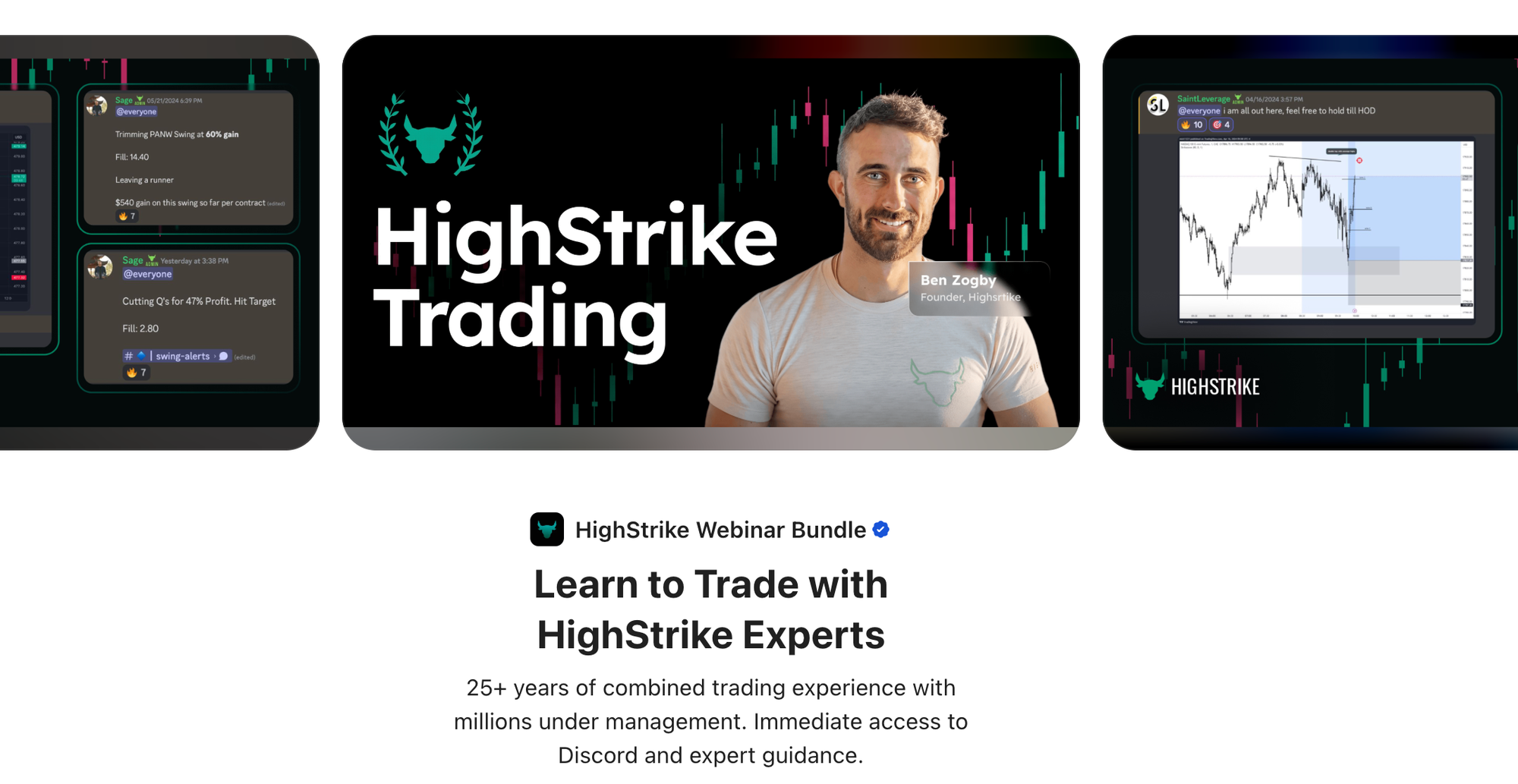
Webinars are a low-hanging fruit of digital products. Once you’ve run a live webinar, simply package up the recording and sell it as a separate product. Not only does this build trust and authority with your audience, but it means you can repurpose content and use it over and over again.
How easy is it? Medium/hard - to sell a recorded webinar with valuable content, you need extensive knowledge on the topic
How much does it cost to start? From $0
How much can you earn? Depending on your expertise on the topic, your webinars can range from $40 to $200+
46. Email workflows
Email is still an integral part of business and is often the easiest way to turn leads into paying customers—but only if it’s done right. By creating and selling pre-built email workflows, you’re offering businesses a shortcut to better engagement and higher conversions.
You can create workflows for multiple scenarios, including abandoned cart sequences, welcome sequences, and post-purchase sequences.
How easy is it? Easy if you have experience in email communication (as brands, creators, etc.)
How much does it cost to start? From $0 - all you need is a platform like Whop to sell your workflows
How much can you earn? From $5 to $10
47. Branding kits
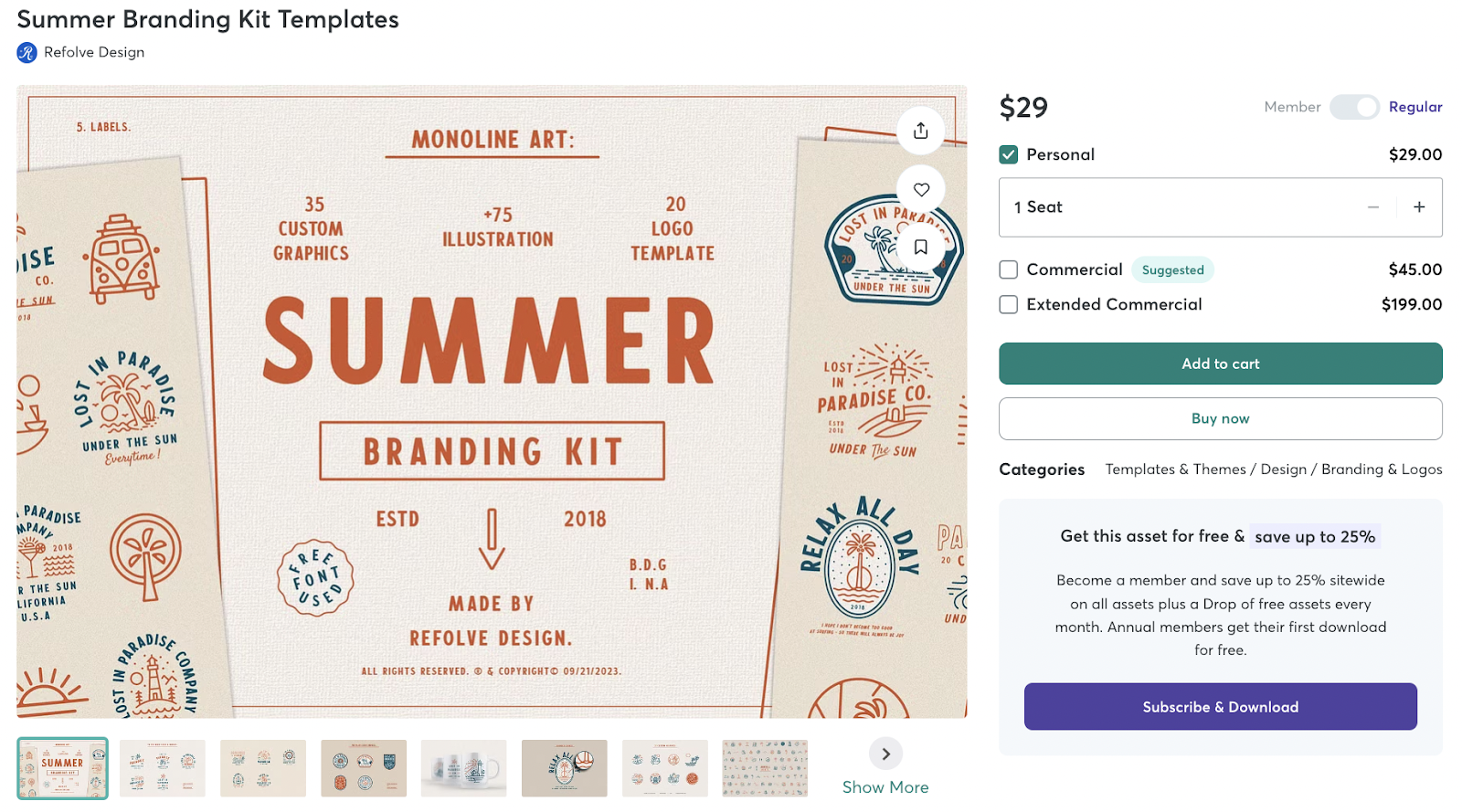
Every business needs a brand, but not every business has the resources or creative know-how to build their own or hire someone to do it for them. If you’ve got a keen eye for design, you can create comprehensive bundles that include logo templates, color palette ideas, and font inspiration.
You’re essentially offering a business-in-a-box solution that saves entrepreneurs from the dreaded “designer’s block” and the expense of hiring a full-time creative team. With the right customization options, your branding kit can cater to various industries which expands your potential reach and customer base.
How easy is it? Medium - you need to be creative and have the graphic design skills to come up with kits that actually sell
How much does it cost to start? From $0 (with platforms like Canva or software like Gimp) to $20 per month (Adobe Creative Cloud Photography plan)
How much can you earn? Branding kits can sell for $20 to $200+ (providing commercial licenses will increate the price)
- Company slogans to inspire your business branding
- Personal branding examples (and how to create your own brand identity)
48. Online assessment tools and calculators
Turn your expertise into engaging, interactive experiences with custom online assessment tools and calculators. You might gauge knowledge with a pre-made quiz, offer personalized health recommendations, or simplify complex financial calculations.
Once you’ve created your assessment tool or calculator, you can either charge people to access it (or, better yet, charge them to see the results) or license it out to other businesses.
How easy is it? Easy to code with tools like ChatGPT, Bolt AI, and Loveable AI
How much does it cost to start? From $0 (might need to subscribe to AI plans in the long run)
How much can you earn? From $10 to $60
49. Knitting and sewing patterns
If you’re good with a needle (or two), turn your skill into sales by creating knitting and sewing patterns. Package up your favorite jumper, hats, or animal stuffies into an easy-to-use pattern that other keen knitters can buy.
Sell your patterns on your own website or use a platform like Whop to promote your products and fulfill orders.
How easy is it? Medium/hard - knowing knitting and sewing enough to create patterns people can follow is a difficult skill to obtain
How much does it cost to start? You can start from $0
How much can you earn? From $3 to $10
50. Animated GIF packs for social media
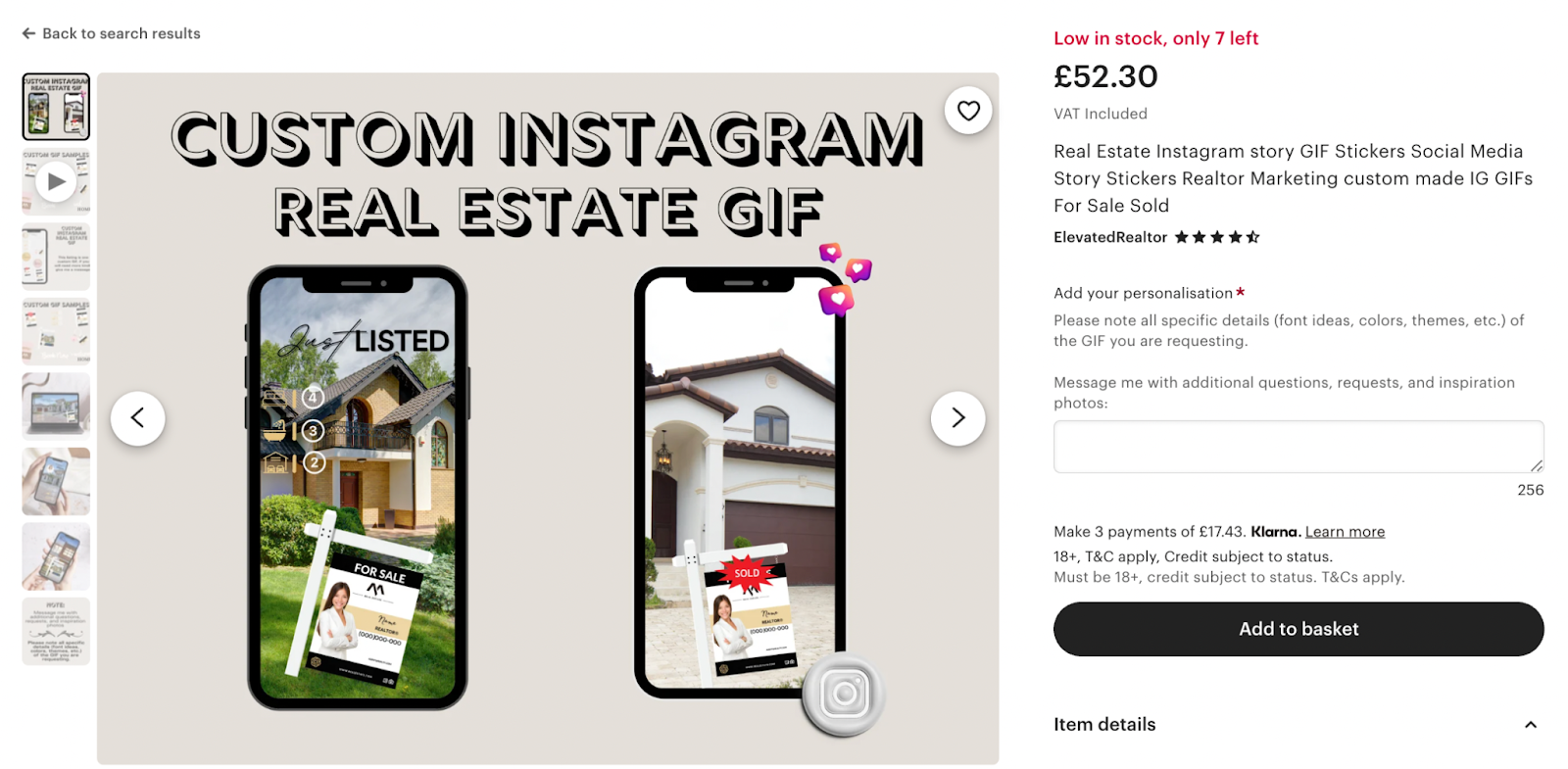
GIFs are the language of Gen Z. By creating custom animated GIF packs that can be used on Instagram, TikTok, and other social media platforms, you’re opening yourself up to sales from one of the fastest-growing demographics.
Shareable, visually appealing content that resonates is really hot right now, so there’s definitely a market for this kind of digital product, whether your GIFs are for branding, marketing campaigns, or just for adding a fun touch to everyday interactions.
How easy is it? Easy, all you need is a software to create gifs
How much does it cost to start? From $0 (with Canva) to $23 per month (with Adobe After Effects subscription)
How much can you earn? From $10 to $50 depending on the contents of your pack
51. Digital scrapbooking kits
Scrapbooking is enjoying a moment in the spotlight at the moment—especially digital scrapbooking. The accompanying kits offer a treasure trove of customizable elements, such as themed backgrounds, decorative embellishments, and stylish fonts, that bring personal projects to life. For creators, digital scrapbooking kits are a golden opportunity to cater to a passionate community on the hunt for unique and easily accessible design resources. They not only make crafting more convenient and mess-free but also open the door to endless creative possibilities.
By offering these kits, you can inspire creativity, nurture a dedicated customer base, and tap into a thriving market of digital crafters who are always looking for new stuff for their next scrapbooking project.
How easy is it? Easy using platforms like Canva
How much does it cost to start? From $0
How much can you earn? Depending on how extensive your kits are, you can sell them from $5 to $20
52. Productivity sound environments
Carefully curated soundscapes, like calming nature sounds and stimulating ambient music, are designed to create the perfect auditory backdrop for any task.
Developing these sound environments gives you an “in” into the wellness and productivity market, where you can license your sound environments on different platforms and to different companies.
How easy is it? Medium - you either have to source the sounds or record them yourself and compose them using software like Audacity or Adobe Audition
How much does it cost to start? From $0 (with Audacity) to $23 per month (Adobe Audition subscription)
How much can you earn? You can sell your sound environments for $20 to $50
53. Virtual interior design mood boards

DIY home improvements are all the rage at the moment—but, just like designing a brand, not many people have the skills to do it justice. Help interior lovers out by creating interactive, customizable mood boards they can use to plan their dream homes.
Either offer them as a download that they can fill out manually or make them integrate with specific design platforms.
How easy is it? Easy using platforms like Canva
How much does it cost to start? From $0
How much can you earn? Mood boards can sell for $10 to $30 - if you can create custom moodboards on request, you can even charge more
54. Digital sheet music or tablature for musicians
Can you read music? If you can, there’s an opportunity at your fingertips. Turn sheet music into downloadable files that musicians can store on their devices or print out to play live.
You’ll need some musical skills here, especially if you’re transforming sheet music from one instrument to another. If you’re feeling really bold, you can also create your own songs for people to download.
How easy is it? Hard - being able to create music sheets and tablature requires good understanding of music theory and a good musical aptitude
How much does it cost to start? From $0 with software like MuseScore studio
How much can you earn? You can sell each sheet from $1 to $10 - custom ones can even go for higher
55. Podcast intro and outro music packs
Podcasts are huge right now, with many consumers citing them as their favorite way to consume content on the go. Developing music packs for podcast hosts to use in their intros and outros is a lucrative opportunity to cater to this rapidly growing community.
By supplying high-quality, royalty-free music tailored to a range of different podcast niches, you can help podcasters polish their production and establish your brand as a go-to source for premium audio content.
How easy is it? Medium - you need to be able to compose music to create into and outro packs
How much does it cost to start? From $0 (with Audacity) to $23 per month (Adobe Audition subscription)
How much can you earn? Into and outro packs can sell for $5 to $20 - you can even bump up the price if you do custom work for clients
56. Custom emoji or sticker packs for messaging apps
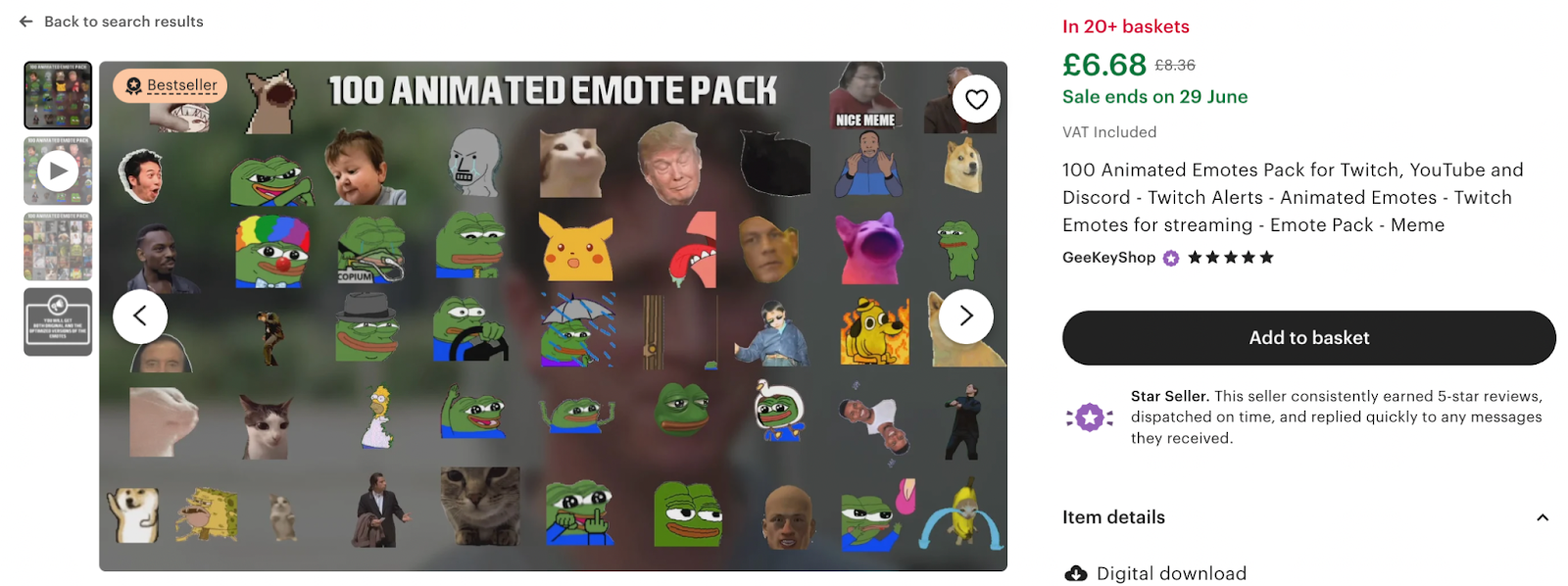
Transform everyday conversations into vibrant expressions with custom emojis and sticker packs. These bespoke packs can help users or companies inject personality and creativity into chats.
You can create a series of packs for different niches or different types of users that you can sell over and over again.
How easy is it? Easy but takes time
How much does it cost to start? From $0
How much can you earn? You can sell emoji/sticker packs for $5 to $10
57. Customizable board games for print-and-play
Who doesn’t love a good board game? If you’re a keen gamer (in the real-world sense), turn your talents to designing a series of board games that your customers can download and play. You can create games for all sorts of tastes and interests, from whodunnit games to card games and everything in between.
Once you’ve designed your suite of games, you can sell them on your website, marketplaces like Etsy, and via your whop.
How easy is it? Medium - creating board games requires game logic and graphic design (in most cases)
How much does it cost to start? From $0 with free platforms like Canva
How much can you earn? You can sell board games from $10 to $50+ based on the complexity of the game
58. Activity packs
Activity packs can work in multiple scenarios, from professional team-building exercises to digital bundles that parents can use to keep their kids occupied. The best part is, you can keep adding to your activity pack library to generate more sales.
Here are some ideas:
- Weekly STEM challenges for 8-12 year olds
- Mindfulness activities for college students
- Holiday-themed craft bundles
- Company team-building scavenger hunts
How easy is it? Easy using AIs like ChatGPT
How much does it cost to start? From $0 (graphics can be made for free using Canva)
How much can you earn? You can sell packs for $5 to $20
59. Template libraries
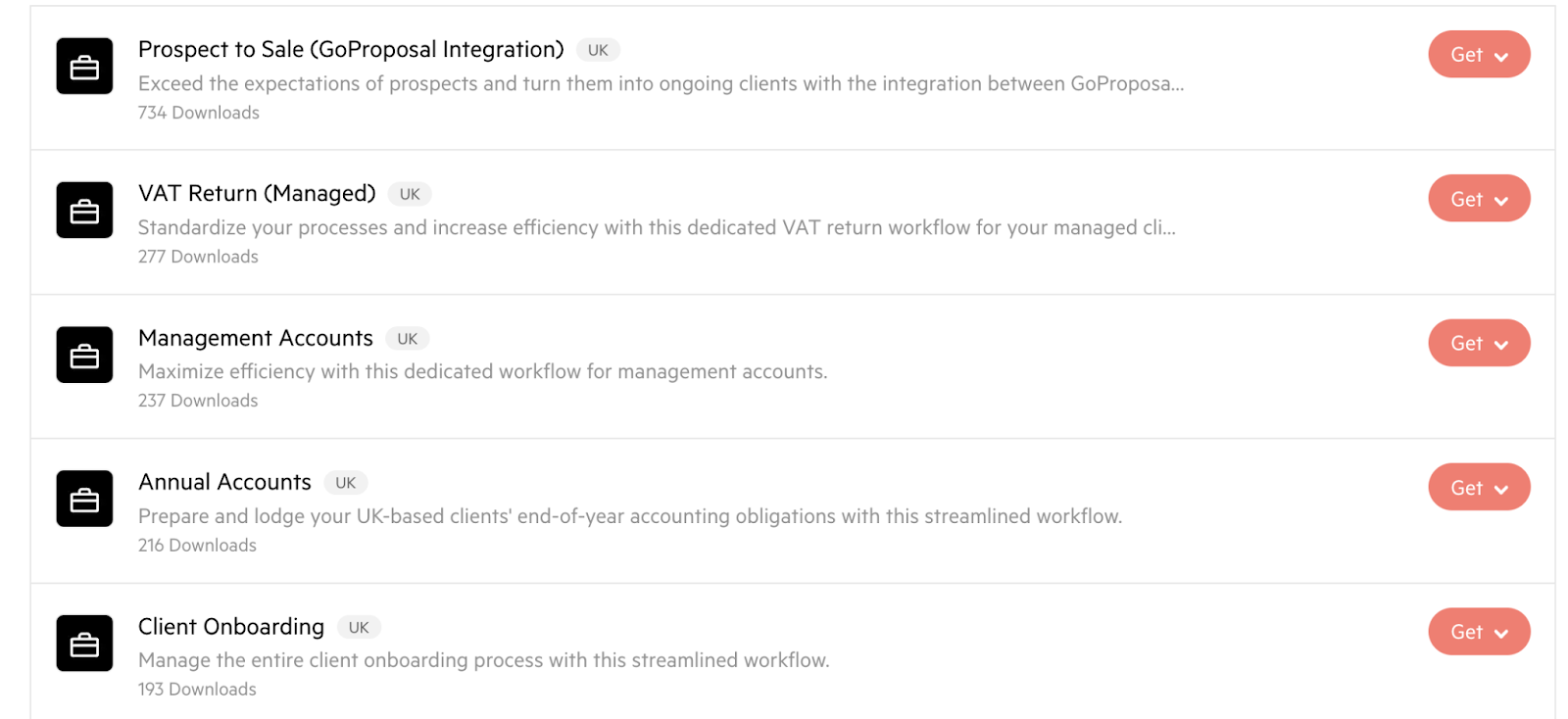
Creatives and business owners need professional-looking materials but they don’t always have the time or skills to create them from scratch. Give them a hand by creating libraries of useful templates, like Instagram Story templates, email newsletter templates, or Canva templates.
You can group together similar template bundles into niche-specific libraries and sell them as a whole.
How easy is it? Medium - depending on the template type you're selling, you might need different skills like graphic design or web development. The content can be made using AI
How much does it cost to start? From $0 with free platforms like Canva
How much can you earn? Template libraries can be sold from $5 to $40+
60. Content calendars
Content calendars are hot property right now as overwhelmed business owners scramble to get their ducks in a row. The beauty is, you can create a calendar once and sell it over and over again. Think industry-specific calendars packed with key dates, promotion ideas, and content prompts to take the headache out of planning.
You can even create versions for different niches—wedding photographers, life coaches, food bloggers, etc. The more targeted, the better they’ll sell.
How easy is it? Easy using AI to create plans and platforms like Notion to create scheduling templates
How much does it cost to start? From $0 using free platforms like ChatGPT and Notion
How much can you earn? You can sell content calendars for $5 to $20
61. Social media strategy worksheets
Most folks are completely winging it with their social media, which is why a strategy worksheet or template can be incredibly useful. You can get as detailed as you like here, with comprehensive workbooks that walk people through defining their audience, crafting their voice, and planning their content pillars.
Add extra value with sections for goal setting, competitor analysis, and metrics tracking, as well as swipe files of high-performing post examples and caption formulas.
How easy is it? Easy/medium - you need social media management skills to create an effective social media strategy worksheet
How much does it cost to start? Free with platforms like Google Sheets and Notion
How much can you earn? From $5 to $25+
62. Digital tarot cards
Digital tarot cards are blowing up right now, especially with the younger crowd who want their spiritual practice to be as mobile as they are.
The key is creating gorgeous, unique designs that stand out from the typical Rider-Waite stock images. Package them with detailed interpretation guides, spread suggestions, and even some journaling prompts. Bonus points if you create themed decks for specific purposes like self-discovery, career guidance, or love readings.
How easy is it? Easy/medium - while you can use AI to generate images for your cards, you'll need drawing or graphic design skills to create high-value ones
How much does it cost to start? From $0 (with platforms like Canva) to $10 (for generative AI subscriptions)
How much can you earn? Depending on if you're selling the cards physically or digitally, they can go for $10 to $80+
63. Virtual museum tours
Virtual museum tours exploded during the pandemic and they’ve continued to be a great way for people to explore art and culture from the comfort of their home.
Go beyond a standard walk-through video and create immersive experiences that combine high-quality visuals with expert commentary, behind-the-scenes tidbits, and interactive elements. Think specialized tours focusing on specific art movements, historical periods, or themes. Package them with downloadable activity sheets for kids, discussion guides for art clubs, or even cocktail recipes inspired by famous artworks.
How easy is it? Medium - creating virtual museum tours requires an extensive knowledge of art and its history. Of course, you can get some help from AI but to create a unique and high-value tour, you need art knowledge
How much does it cost to start? From $0
How much can you earn? You can sell virtual museum tours for $20 to $100+ depending on the museum and the quality of the tour
64. Digital city walking tours

People use digital city walking tours to explore their own cities or plan future trips in detail.
The secret is to create tours that tell a story—whether it's following the footsteps of famous writers in Paris, hunting down the best street art in Melbourne, or exploring hidden food gems in Tokyo. Package them with downloadable maps, local insider tips, and restaurant recommendations. Make them available in both audio and written formats, and throw in some gorgeous photography.
How easy is it? Medium - digital city walking tours requires time and knowledge of the city you're creating the tour for. While AI can assist you in creating the tour, you will still need to put in unique content to it
How much does it cost to start? From $0
How much can you earn? Digital city walking tours can sell from $30 to $80
65. Directories
Directories help people find businesses or vendors. The key is tapping into super-specific niches where people are desperately searching for vetted resources—think sustainable wedding vendors, certified pet behaviorists, or ethical fashion manufacturers.
The money isn't just in selling listings, it's in creating a comprehensive resource that includes detailed profiles, reviews, and direct booking capabilities.
How easy is it? Easy using AI
How much does it cost to start? From $0
How much can you earn? Depending on the directory type and how extensive its contents are, you can sell them for $10 to $50
66. Meditation audios
Create themed meditation series that target specific life moments or challenges. Think "Meditations for Entrepreneurs," "Calm Commute Series," or "Parent-Child Bedtime Mindfulness."
The key is professional sound quality and unique background music (properly licensed, of course). You can sell the audio files with printable journals, habit trackers, and maybe even some beautiful artwork for an extra bump of revenue.
How easy is it? Easy/medium - to compose meditation audios, you'll either source them from the internet or record some audio yourself. Then, you'll need to compose them using tools like Audacity or Adobe Audition
How much does it cost to start? From $0 (with Audacity) to $23 per month (Adobe Audition subscription)
How much can you earn? From $10 to $50
67. Online masterminds

Masterminds are slightly different from online courses and memberships because they bring together a tight-knit group of people who all want to reach the same goal. They tend to include group coaching calls, homework, and set activities that help members get to that goal.
Most masterminds come with premium prices because they’re so specific and because they tend to include a lot of facetime with the mastermind host. To do this well, you need to specialize in something that people want.
How easy is it? Easy/medium - organizing online masterminds requires you to have some knowledge on the topic the mastermind is about
How much does it cost to start? From $0 using platforms like Whop
How much can you earn? From $50 to $200
68. Sound effects
From podcast producers to app developers, meditation teachers to online course creators, everyone needs quality audio. The key is creating themed packs that solve specific needs. Think "Zen Garden Ambience," "Startup Office Atmosphere," or "Retro Gaming Effects."
You can sell your sound effects on stock sound websites or create your own website or Whop where you can sell them to your own audience.
How easy is it? Easy/medium - you need some sound editing skills to create usable sound effects
How much does it cost to start? From $0 (with Audacity) to $23 per month (Adobe Audition subscription)
How much can you earn? From $1 to $20 per sound effect
69. Niche tools
Here's where you can really geek out—create super-specific tools that solve exact problems in your niche.
Maybe it's a podcast promotion calculator, a website color scheme generator, or a recipe cost analyzer for food bloggers. The beauty of niche tools is that they practically sell themselves when you hit the right pain point.
Tip: Create both basic and premium versions to capture different market segments.
How easy is it? Medium - finding the niche to solve a problem for can be time consuming and since we're talking super-specific tools, you'll need some software/web development skills as well
How much does it cost to start? From $0
How much can you earn? Depending on the niche and tool, you can sell them for $20 to $200+
Need inspiration? Check out these free business tools and the best ecommerce automation tools
70. Craft patterns
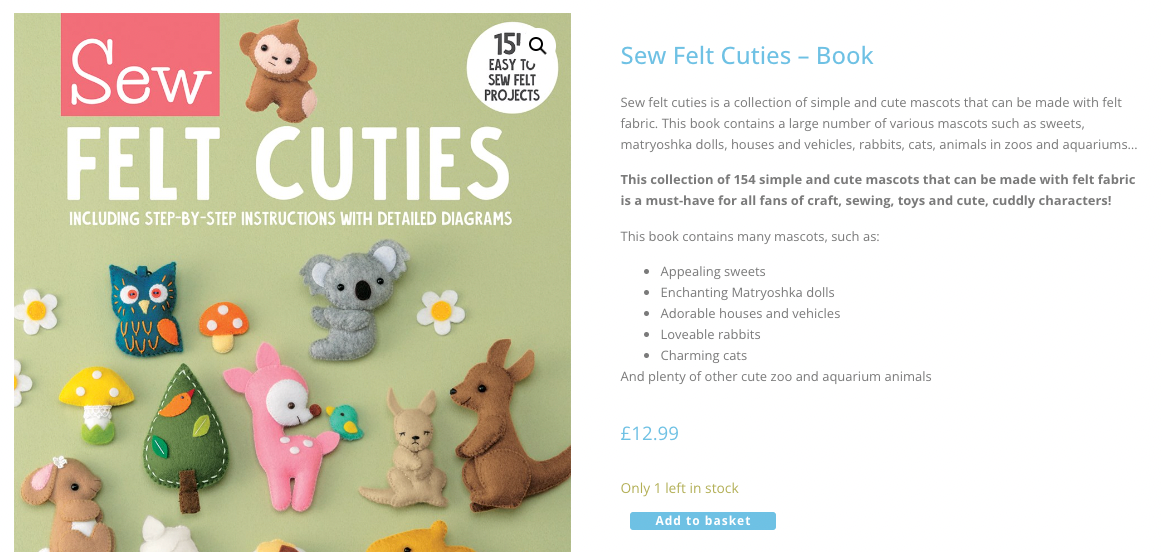
Tap into the craft market by selling patterns with crystal-clear instructions and lots of how-to photos. Consider creating patterns for trending items (like chunky knit blankets) but with a unique twist and package them with video tutorials, size variations, and material calculators.
How easy is it? Easy/medium - creating craft patterns requires craft and graphic design knowledge. While the graphic design part isn't extensive, you should have craft skill that's good enough to create patterns
How much does it cost to start? From $0
How much can you earn? From $10 to $40 per pattern (depending on the complexity)
71. Ezines and digital magazines
What a blast from the past! The secret to successful ezines is creating highly targeted content that readers can't find anywhere else. Think industry deep-dives, expert interviews, and exclusive how-tos with downloadable resources, templates, and actionable worksheets.
You can even create annual collections and special editions or offer white-label versions that businesses can customize for their own audiences.
How easy is it? Easy using AI and spending a bit of daily time researching
How much does it cost to start? From $0 to $43 (for platforms like Beehiiv)
How much can you earn? From $5 to $20 per month
72. Teaching materials
Educators are desperately seeking fresh, engaging materials that work both in-person and online. Create comprehensive bundles including lesson plans, worksheets, assessment tools, and interactive activities.
Take it one step further and make everything customizable and include options for different learning styles. Team your flashcards and learning materials with progress-tracking tools, parent communication templates, and modification suggestions for special needs students.
How easy is it? Easy using AI, medium if complex teaching materials
How much does it cost to start? From $0 to $20 (for AI subscriptions in the long run)
How much can you earn? From $5 to hundreds of dollar depending on the topic of the teaching material
Explore these side hustles for teachers
73. Study guides
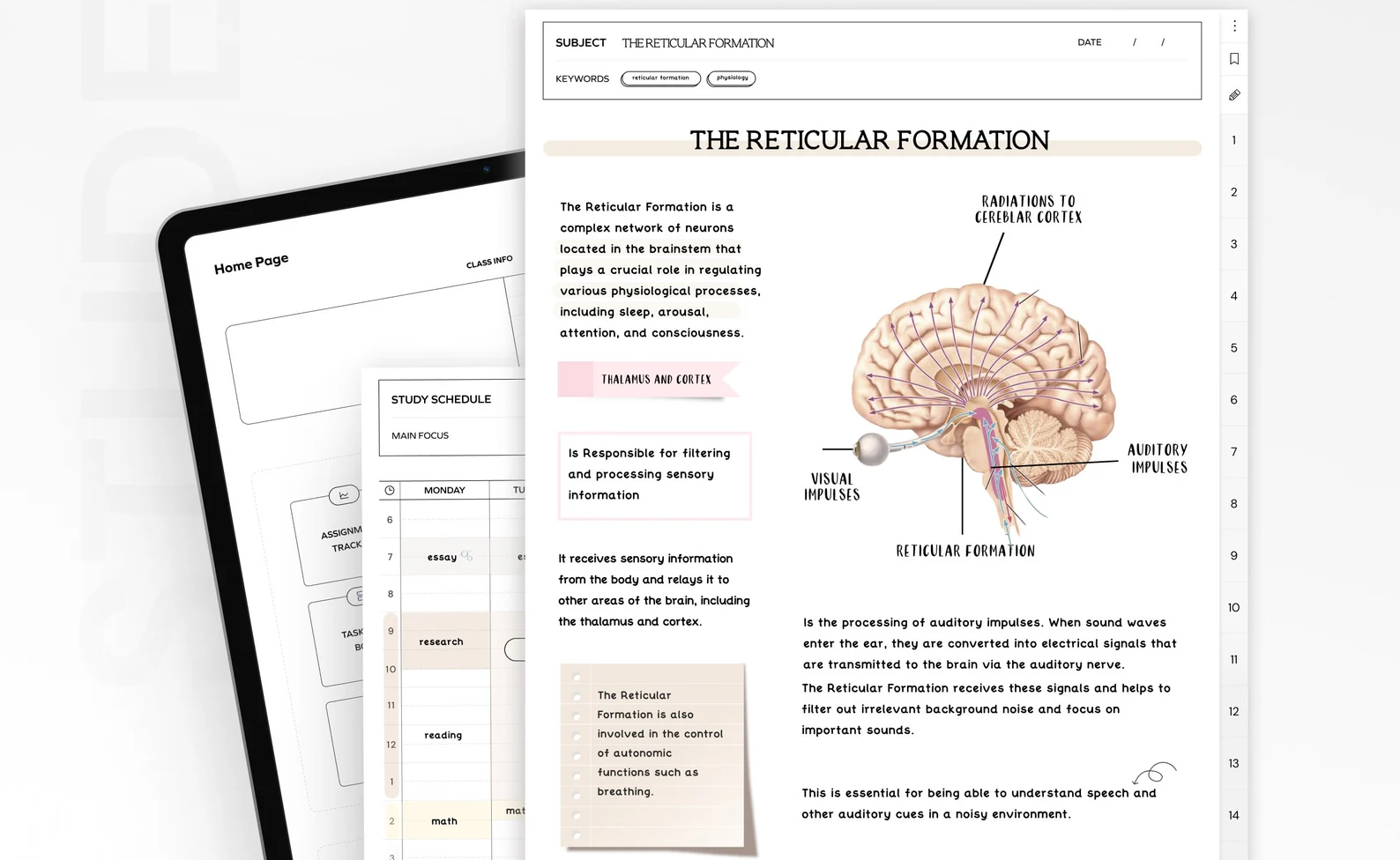
Students will always need study guides, but they want something different from the boring old PDFs. Create interactive study materials that combine clear explanations with practice questions, memory techniques, and quick reference charts. Include different learning formats (visual, auditory, kinesthetic) and practice test generators.
Tip: You can also upload your study notes to various sites to earn extra income.
How easy is it? Easy/medium using AI
How much does it cost to start? From $0 to $20 (for the graphic design apps)
How much can you earn? From $5 to $20
74. Social media prompts
Everyone's telling businesses they need to be on social media, but nobody's giving them the actual words to say—here’s your opportunity.
Create extensive prompt libraries for different industries, occasions, and content types. Think daily conversation starters, behind-the-scenes prompts, and engagement questions packaged up with hashtag suggestions, best posting times, and engagement tracking sheets.
How easy is it? Easy using AI
How much does it cost to start? From $0
How much can you earn? From $5 to $20+
75. Professional templates and documents
Professional templates save people time and make them look good. Create bundles for different industries and needs: contracts for freelancers, proposals for agencies, and invoices for service providers.
The key is making them both legally sound and beautifully designed. Package them with customization guides, usage tips, and regular updates as laws or industry standards change. Try including both Word and Google Docs versions, plus how-to videos for easy customization.
How easy is it? Easy using AI and free platforms like Google Docs and Sheets
How much does it cost to start? From $0 to $20 (for AI subscriptions in the long run)
How much can you earn? Depending on how extensive the template/document is from $5 to $50+
76. Digital art commissions (customized digital portraits or illustrations)
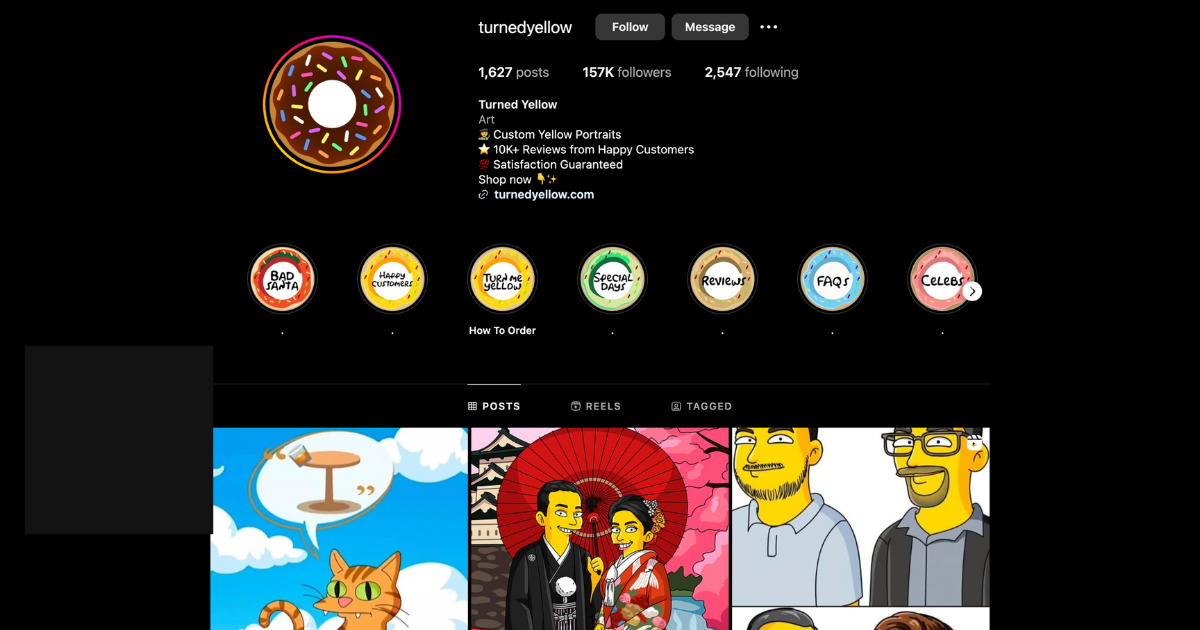
If you’re a dab hand with art and illustration, why not offer custom portraits and illustrations in your own style? Portraits and personalized artwork make for great gifts, and doing custom work allows you to charge a higher price than you can for prints.
You can grow a following by posting your art on social media and collaborating with accounts of a similar style. Then, use a digital marketplace to offer customs and commissions.
How easy is it? Easy if using AI, hard if creating art comissions yourself
How much does it cost to start? From $0 to $10 (for subscriptions to AIs like MidJourney)
How much can you earn? From $5 (AI-made) to $100+ (self-made)
77. Custom workout plans
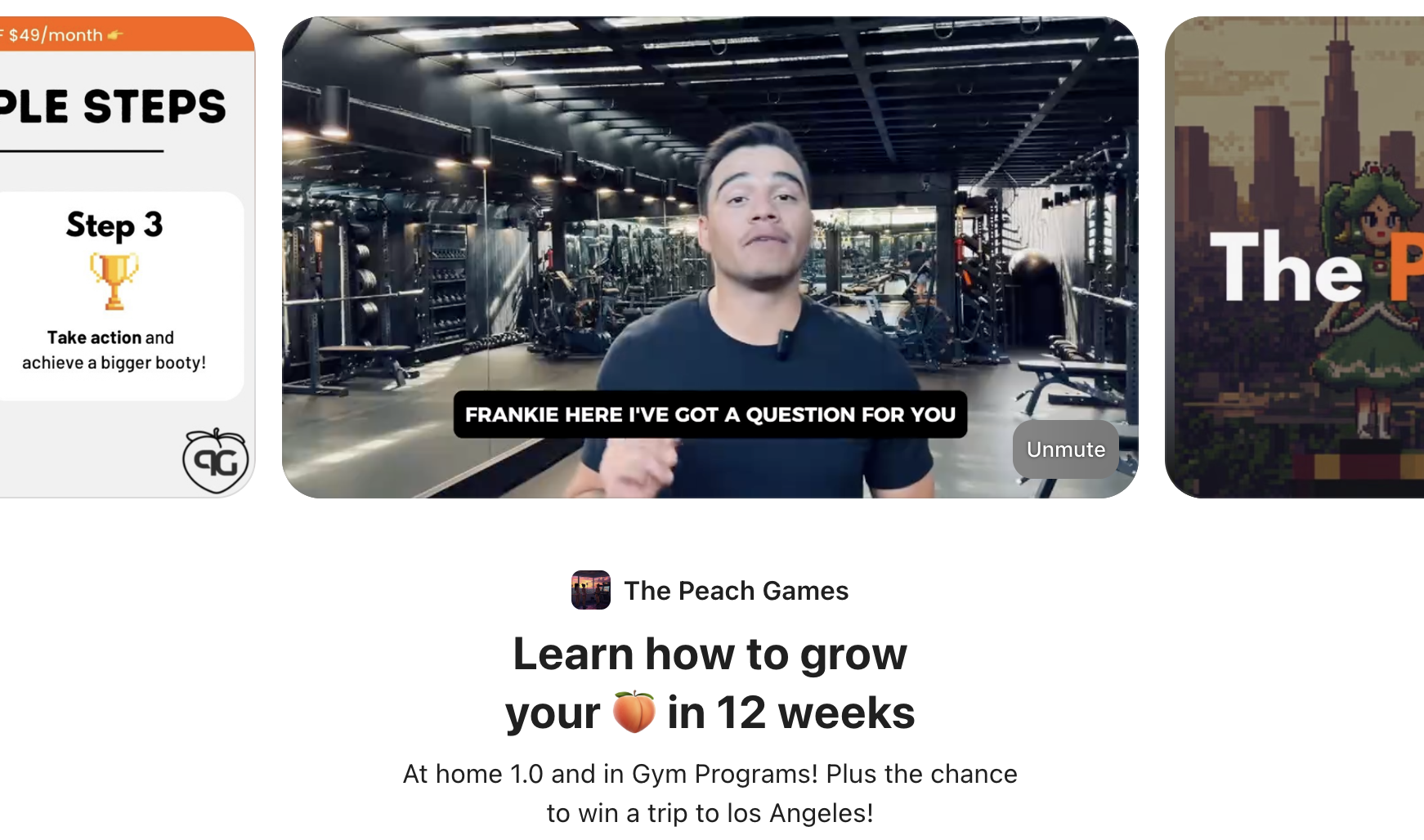
There’s never been a bad time to create fitness products – just look at the ongoing success of Jane Fonda’s Original Workout VHS from the 80s. These days though, people are tired of cookie-cutter approaches to fitness.
They want something personalized and tailored to their situation and goals. If you have a background in health and fitness, or have overcome your own training difficulties, consider creating workout plans for others!
How easy is it? Easy if you're creating generic plans - medium if you're creating custom plans per client
How much does it cost to start? From $0
How much can you earn? From $10 to $100+
78. Custom website themes for platforms like Shopify or Squarespace
Maybe you don’t want to build full on website templates, but you like the idea of creating themes for Shopify or Squarespace. The themes that come for free with these platforms are generally pretty basic, but creating themes requires a lot less technical know-how than a full-spec website.
You can design themes for a niche or industry or follow your style. Perfect for intermediate designers and techheads.
How easy is it? Hard - creating custom themes for platforms like Shopify or Squarespace requires good understanding of the platforms and web development skills. While you can get help from AI, creating unique themes that sell is hard
How much does it cost to start? From $0
How much can you earn? From $50 to $1.000+
79. Digital party invitations or event templates
Bespoke invitations are all the rage, but not everyone can afford an event planner. If you’re creative, why not create templates for invitations and events? You can use software like Illustrator and Canva to create your designs, upload them to a digital marketplace, and post your work on social media to build a following.
Plus, once you grow, you can offer customized designs for clients and run an online storefront of ready-to-go templates.
How easy is it? Easy with platforms like Canva
How much does it cost to start? From $0
How much can you earn? From $5 to $20 per invite
80. Resume and cover letter templates
Sure, Canva has resume templates. But here’s the thing – everyone’s using them now, and nobody is standing out. People are struggling enough to write their own resumes, let alone design them. So if you’re good with layout design, why not create templates for others (or commission customs)?
Same as most creative digital products, you’ll need to post your work on social media, create content around it, and funnel viewers to an online storefront or intake form (for commissions).
How easy is it? Easy with platforms like Canva but uniqueness is very important
How much does it cost to start? From $0
How much can you earn? From $10 to $20 per resume
81. Customizable meal plans or recipes

For many people (okay, yes, me personally), meal planning is a huge pain. Not everyone has the time (or the creativity) to think of healthy, easy-to-follow meal plans. But if you’ve got a passion for food, creating customizable meal plans or recipe collections could be the perfect digital product to sell.
You can design meal plans based on specific dietary needs (think keto, vegan, or gluten-free), or create general plans that help people eat healthier throughout the week. Platforms like Canva can help you format them beautifully, and you can offer the option to personalize the plans for clients with particular preferences.
Once you’ve got your templates, list them on a digital marketplace and market them through social media platforms, where you can share meal prep tips or recipe ideas to engage your audience.
How easy is it? Easy if you're creating generic plans - medium if you're creating custom plans per client
How much does it cost to start? From $0
How much can you earn? From $30 to $100+
Find out how you can sell meal plans online and make passive income
82. Podcasting resources (show notes templates, episode planners)
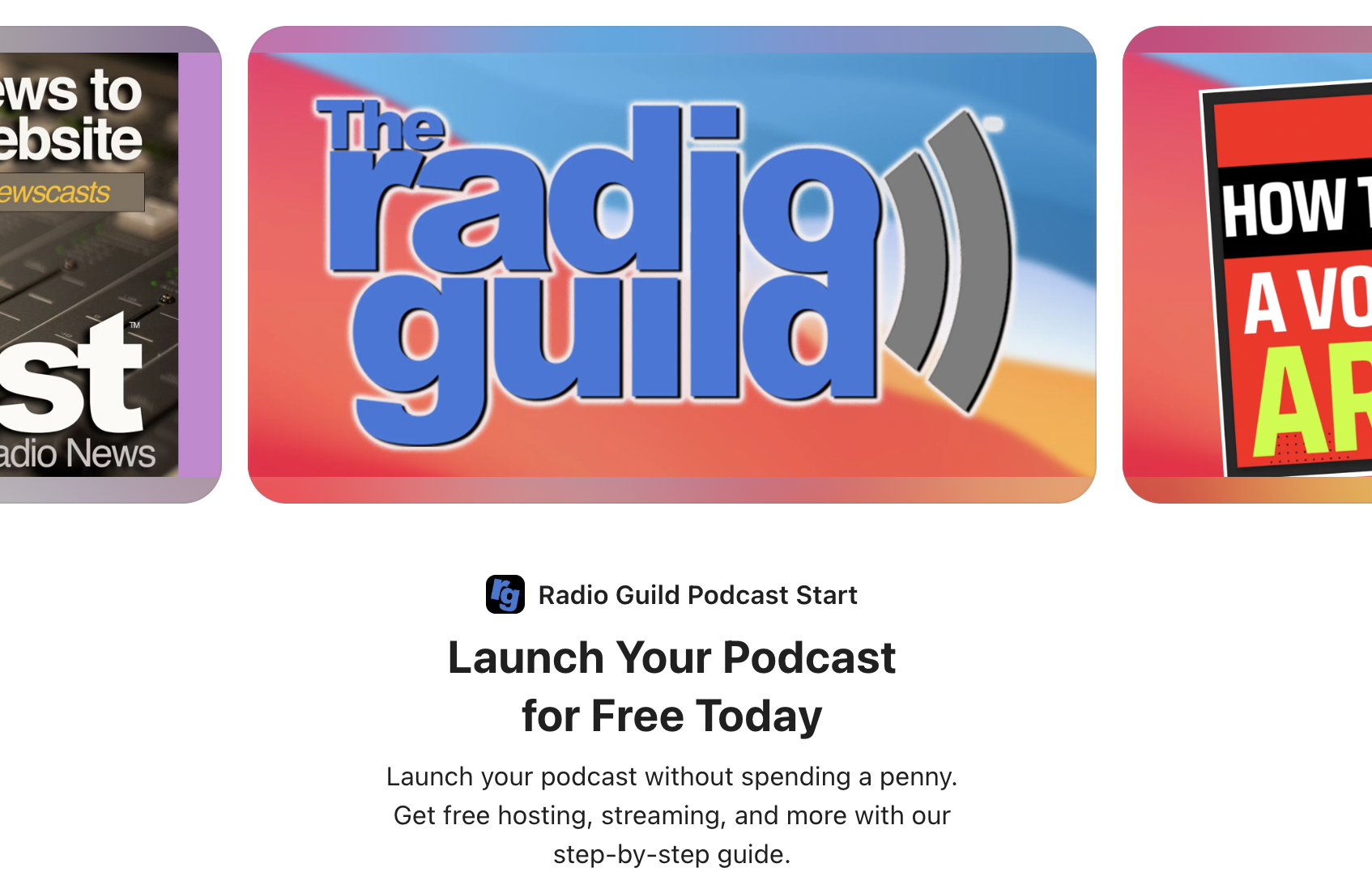
Everyone has a podcast these days, right? Turns out, running them is actually pretty tough work behind the scenes. Once creators begin to grow, they have less time and energy for things like show notes and episode planning. That’s where you come in.
You can design templates and planners to help podcasters keep everything in order, from episode outlines to marketing strategies. Sell your templates on Etsy, or bundle them into a product suite for aspiring podcasters. As your audience grows, you could offer a subscription for regular new templates or coaching to help people level up their podcast game.
How easy is it? Easy with the help of AI
How much does it cost to start? From $0
How much can you earn? From $10 to $50+
83. Virtual styling consultations (personalized fashion advice)
We’ve all seen those colour consultation Reels popping up on our feeds, right? Personalized fashion advice is having a big moment now, from wardrobe styling to colour theory. Even Instagram hair stylists offer digital consultations to their worldwide followers who can’t book with them in person.
But to offer personalized advice, coaching, or consultations, you need to be somebody people listen to. Curate your social media to reflect your style, and create content around personalized advice.
How easy is it? Medium/hard - to be able provide good consultations, you need a really good understanding of fashion and styling
How much does it cost to start? From $0 with platforms like Whop
How much can you earn? From $50 to $500+
84. Digital mockups for product designs
Every designer uses mockups, from branding to product design, packaging to billboards.
If you're skilled at design, you can curate a whole storefront of mockups to help designers and creators present their work in the best light (without needing to photograph the real thing).
You can offer different settings for lighting, contrast, shadows, and effects within the mockups to give your customers various options – check out YouTube for Photoshop tutorials.
Once you build a collection you’re happy with, you can sell them on marketplaces or your website.
How easy is it? Easy if you're creating AI-made mockup but medium/hard if you're creating mockups in 3D environments yourself
How much does it cost to start? From $0 to $20 (for generative AIs)
How much can you earn? From $10 to $150+
85. Custom animated logos or intros for videos
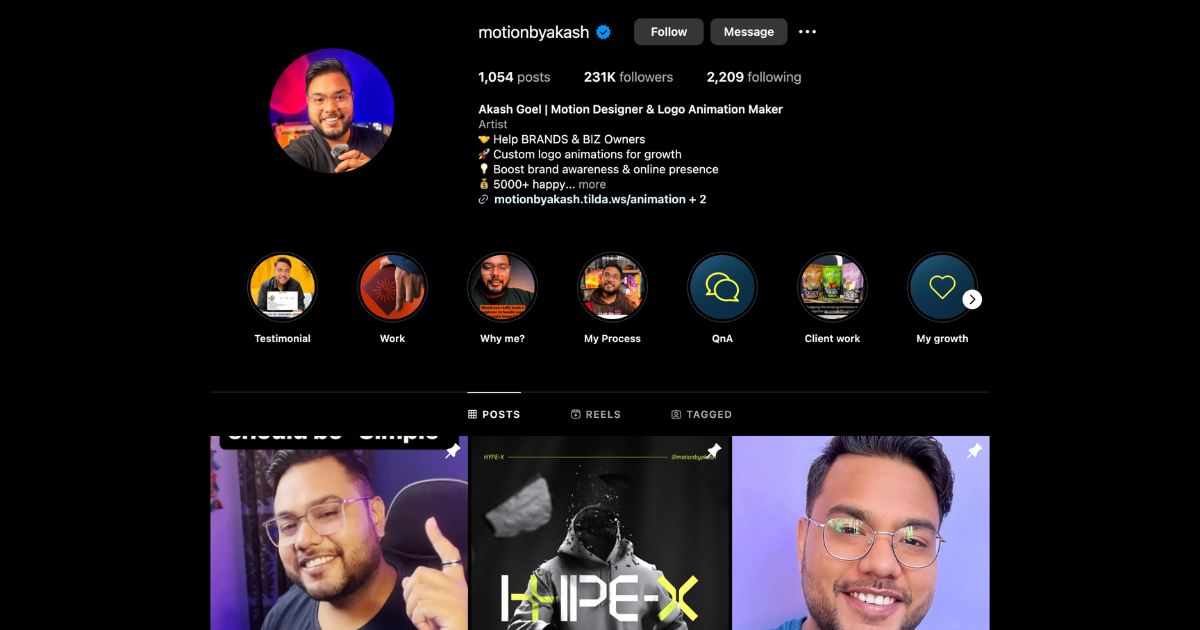
Think of your favorite YouTuber’s intro – chances are, somebody was commissioned to create it.
From animations to 3D rendering, cartoons to type effects, you can create many kinds of intros, so long as you know your way around basic graphic and video editing software.
Set up an online storefront and promote your work on social media sites like Pinterest to show off your skills.
How easy is it? Medium - creating animated logos requires animation and software (like After Effects) skills
How much does it cost to start? From $23 per month (for software like Adobe After Effects)
How much can you earn? From $50 to $200+
86. Digital assets for bullet journaling
Remember when bullet journaling was all the rage? Well, it still has a diehard community, but many have turned to digital-based planners housed on tablets and flipbooks.
If you love design and have a knack for organization, creating digital bullet journal assets could be your thing. You might create pre-made spreads for daily logs, habit trackers, cute stickers, mood trackers, weekly and monthly layouts, or inspirational quotes.
With apps like GoodNotes or Notability, people can easily import and personalize your designs on their tablets or devices.
Once you’ve got a set of digital spreads, sell them through an online store and share your designs on Instagram or Pinterest to attract the bullet journaling community.
How easy is it? Easy with platforms like Google Docs
How much does it cost to start? From $0
How much can you earn? From $10 to $30
87. Online language learning tools or quizzes

If you’re fluent in a language (or multiple), you can make money online with language learning tools or quizzes to help others improve their skills. You can design interactive quizzes, flashcards, vocabulary lists, grammar guides, and pronunciation practice exercises.
The beauty of digital tools is that they can be easily shared and accessed on any device, making learning super convenient. Use platforms like Whop to welcome clients and house resources. You can even use the chat functions to give feedback and offer personalized tutoring, if you wish.
Plus, you can target beginners, intermediate learners, or even niche audiences (like business language or travel phrases). Share your creations on social media, run giveaways, or create a blog around your language-learning resources to build a community.
You can sell language lessons, courses, quizzes and workbooks in your whop.
How easy is it? Easy if you're creating tools and quizzes with AI but if you ever want to scale and provide one-to-one services, you'll need to be very fluent in at least two languages
How much does it cost to start? From $0 to $20 (for AI subscriptions)
How much can you earn? From $10 to $100
Learn how to teach English online with this step-by-step guide
88. Custom mobile wallpapers, themes and widgets
Everyone loves customizing their phones, but not everyone has the skills to make their devices unique.
If you’re creative and have a flair for design, you could consider designing packages that include matching wallpapers, app icons, and widget designs that fit a particular vibe (boho, minimalist, vintage, you get the idea).
You can also design widgets that show the weather, to-do lists, or inspirational quotes, making a phone look good and useful. Sell your creations through digital marketplaces or on your own website, and use Instagram and Pinterest to show off your work and give followers sneak peeks.
How easy is it? Easy with AI
How much does it cost to start? From $0 to $10 per month for subscriptions to AIs like MidJourney
How much can you earn? From $5 to $20
89. Business card templates
Business cards are important for most professionals, but paying a designer to create one is often out of budget for those just getting started, and the free ones available are, well, free for a reason.
But if you know your way around Illustrator, InDesign or Canva, you can create business card templates that make a strong impression without customers breaking their bank. Try to design various styles for your storefront: sleek and modern, quirky and fun, minimalist, bold, etc.
Once your designs are ready, sell them through digital marketplaces or on your own website.
How easy is it? Medium - to be able to create unique business card templates, you'll need graphic design skills and know how to use software like InDesign or Canva
How much does it cost to start? From $0 (for platforms like Canva) to $23 per month (for software like Adobe InDesign)
How much can you earn? From $10 to $50
Take a look at these digital business card examples for inspiration
90. 3D models
If you can use 3D design software (like Blender, AutoCAD, or Maya) then you could always create and sell 3D models to be used in all sorts of projects, from video games and VR to architecture and product design.
You might choose to create characters, object designs, environments, or abstract designs – pretty much all are in high demand for people building immersive digital experiences online (and this is becoming more and more popular with Web3).
You’ll want to build an audience, portfolio, and credibility – so do all 3 at once and post your models and designs on Instagram, Pinterest, and Behance – where visuals are best displayed. You can sell your models on your own website or through online marketplaces. There are even marketplaces built specifically selling 3D assets, like TurboSquid and CGTrader.
How easy is it? Hard - to be able to create 3D models in software like Blender, you need good 3D modelling skills
How much does it cost to start? From $0 (since Blender is free and is one of the most popular 3D modelling software out there)
How much can you earn? From $10 to $100+
91. Customizable TikTok and Reels templates
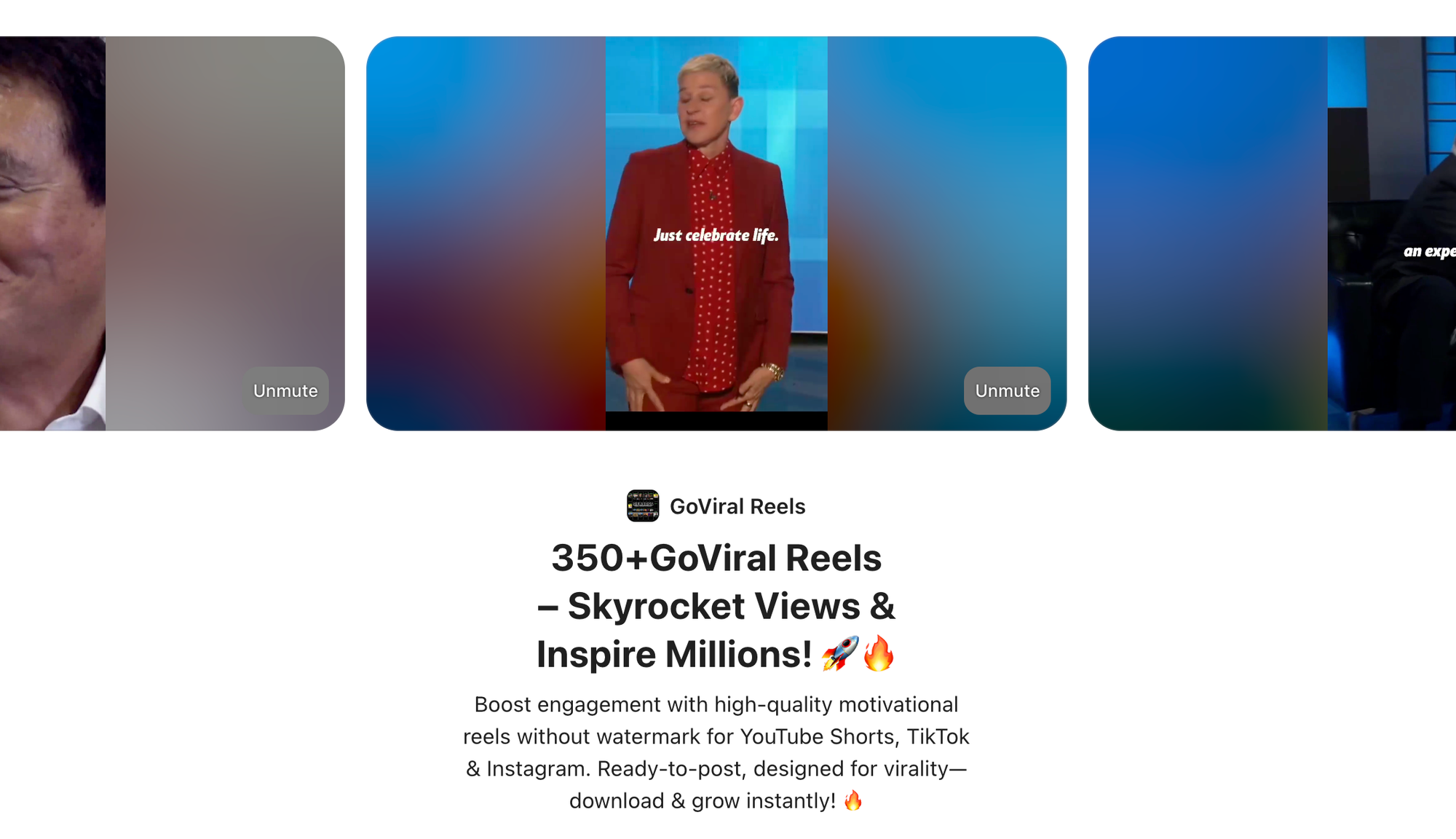
TikTok and Reels are the main focus for most creators nowadays, as they give the best chance of going viral. Well, for anybody aiming to go viral, good editing is an essential. And the truth is, not all talented creators are talented editors, too.
While outsourcing is an option, it’s costly, and customizable templates allow creators with little editing experience to create and publish polished content.
That’s where you come in. If you know the basics of video editing and design, you can create short-form video templates (on beginner friendly platforms like Canva) for creators to edit their videos with. Keep it simple, and give people room to play with the designs and make them their own.
You can build templates for text animations, transitions, intros, outros, overlays, and more. Sell them on a digital product marketplace like Whop, and use your TikTok and Instagram accounts to promote your work.
How easy is it? Easy/medium with apps like CapCut and Premiere Pro
How much does it cost to start? From $0 to $23 (for subscriptions to CapCut premium or Premiere Pro)
How much can you earn? From $5 to $50 per template
92. Digital art challenges and prompts for artists
Illustration and design challenges are popular on social media, but the creators running them rarely have time to interact with participants, give feedback, or even give very detailed prompts.
If you’re a creative, you could create digital art packs that help other artists break out of creative blocks. The packs could include daily or weekly prompts, challenges, and tips or tricks. Users can purchase them to pick up their practice, build their portfolios with quality work, and repurpose as content for social media. Plus, they get the benefit of being able to share their work with you directly for feedback.
You can even build a community chat if you sell your packs on Whop, allowing all customers to interact with one another.
This product is super low-effort for you to produce once the prompts and challenges are thought of, and it can be easily marketed to artistic communities on Instagram.
How easy is it? Easy using AIs like ChatGPT
How much does it cost to start? From $0
How much can you earn? From $1 to $5 per challenge/prompt
93. Interactive personality tests
Sure, there are plenty of free personality quizzes out there. But the key to making money from them is providing a more personalized and in-depth experience than the free ones offer (besides, most of them are a ploy to get your email anyway).
You can create all sorts of niche quizzes, from astrology based to rooted in psychology, career to fashion, and all avenues of self discovery. Think of how you can add a premium touch – maybe you provide downloadable reports, or follow up emails or calls.
Evelina Milenova, Growth Manager at Opinion Stage, notes that while AI makes it easy to launch sellable quizzes, the real value comes from fine-tuning the experience: "You can quickly create personality tests with an AI quiz maker and tweak them based on what works. The goal isn’t just speed - it’s about delivering an experience that feels personal and worth paying for. A style quiz, for example, can match someone with a fashion persona and suggest outfits that fit their taste, turning a fun experience into a sales tool."
With pretty much any digital product, free versions exist. The point is that people are willing to pay for refined, exclusive, valuable experiences and products that feel more custom to them.
Once your quiz is set up, you can host it on Whop and promote it through social media or email lists.
How easy is it? Easy to create the tests with AIs like ChatGPT and the platform itself with AIs like Bolt or Loveable - then, you can sell access to them by using Whop
How much does it cost to start? From $0 to $10 (for AI subscriptions)
How much can you earn? From $10 per access sold
94. Customizable digital vision boards
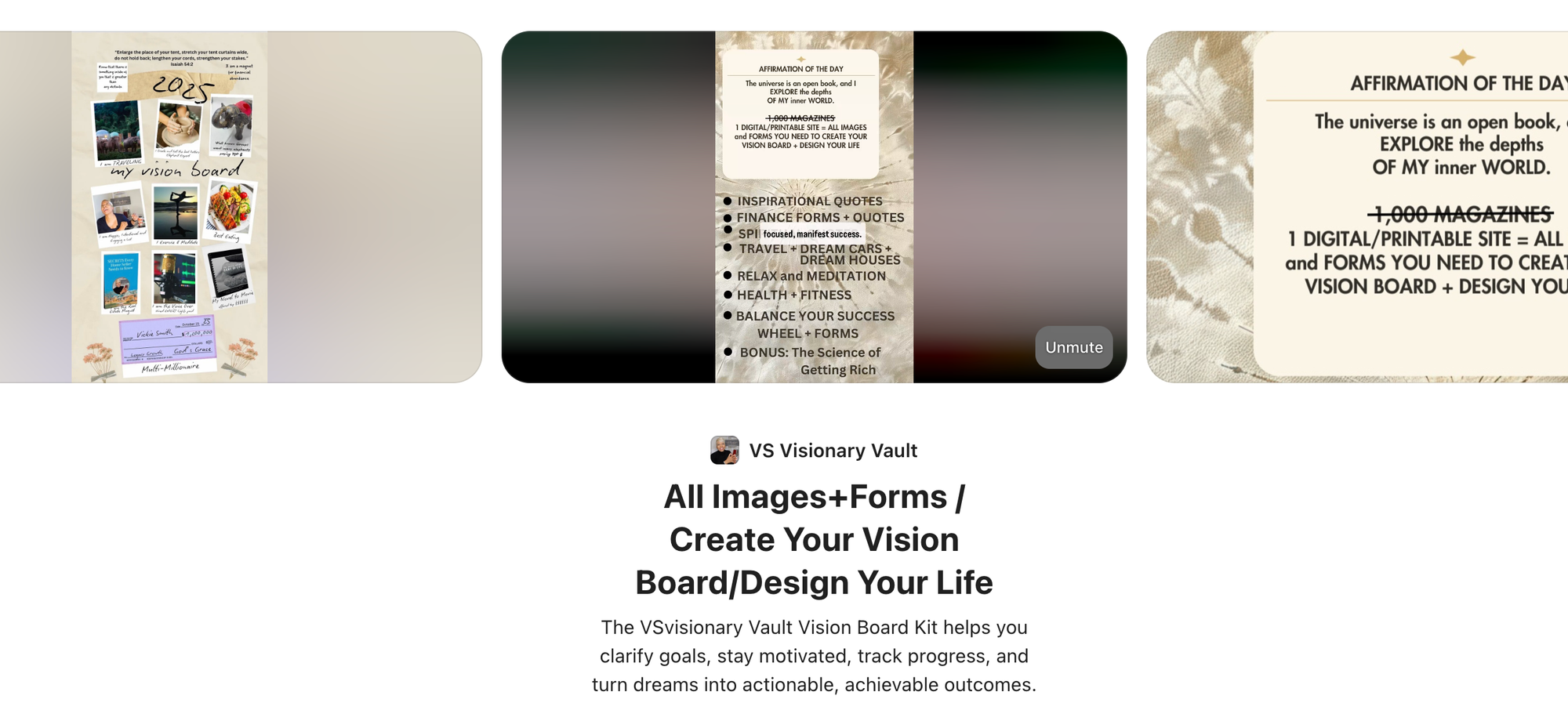
Vision boards aren’t solely for the boho types anymore, they’re becoming an essential asset for all kinds of entrepreneurs, business owners, and big-dreamers.
These boards are a tool people can use to better train their subconscious mind to improve real-life circumstances through the (very real and proven) science of visualisation. While I love to build my own, it can be a lengthy and time-consuming process. And if you weren’t creative by nature, I can see how it could feel frustrating rather than enlightening.
But, if you’re like me, you could create digital vision board packs that people can personalize with their own images, quotes, and goals. You can build various themes (travel, fitness, business) in varying styles, with custom imagery, graphics, sticker options, typography, and more.
Then, buyers can simply upload their own photos and tweak things to suit their vision.
How easy is it? Easy since it only takes time and a little creativity
How much does it cost to start? From $0
How much can you earn? From $5 to $30 per board sold
95. Digital adventure maps
City guides, hiking tails, or even scavenger hunt routes that users can personalize with their own points of interest, field notes, and hidden gems. You can create themed maps inspired by apps like Pokemon GO and Geocaching, where users search for locations and items, or complete tasks as they explore.
Use Adobe Illustrator or Canva to design your maps – or you can use platforms like Mapbox or Google My Maps for more detailed experiences and customizable paths.
Instagram Reels and TikTok are the best places to post your adventure routes and bring them to life, using a link in your bio to refer viewers to your digital storefront.
How easy is it? Easy/medium depending on the topic and difficulty of the adventure
How much does it cost to start? From $0 to $23 per month (for Adobe subscriptions)
How much can you earn? From $10 to $30
96. Interactive stories
If you have a knack for storytelling or if you have an idea for a story, you should consider making it a reality by using apps like ChatGPT or Gemini to create an interactive story game.
While creating text-based interactive story games might sound a bit hard for people who don't know how to code, it's actually fairly simple to do. If you have access to the apps we've mentioned (ChatGPT and Gemini), it's even easier.
You can create a game as a software, a mobile app, or a web app. Utilizing tools like Bolt.new or Loveable AI will make your job easier if you're considering the latter.
After creating the game, you can monetize it on Whop using the Software or Web apps on your whop.
How easy is it? Easy using AIs like ChatGPT to write the story and Bolt or Loveable to write the app
How much does it cost to start? From $0 to $20 (for AI subscriptions based on the complexity of the story/app)
How much can you earn? From $5 to $20
97. YouTube thumbnails

If you're following any internet personalities that focus on making money online or even scroll through social media daily, there's a high chance you've heard of people making money through YouTube.
One of the most essential parts of a good YouTube channel is great thumbnails - they play a huge role in click through rates. So, there are a lot of YouTubers looking for talented people to create thumbnails for their videos - there's a market for it.
If you're skilled in graphic design apps like Photoshop, Gimp, or even Canva, you can offer custom thumbnail services through freelancing websites like Fiverr and Upwork, or even better, your very own whop.
How easy is it? Medium/hard - while creating generic YouTube thumbnails is relatively easy, creating top notch ones requires graphic design skills and creativity
How much does it cost to start? From $0 (for platforms like Canva) to $23 per month (for Adobe Photoshop)
How much can you earn? From $10 to $100+
98. Stream overlays
If you've ever watched a stream, especially a gaming-focused one, you've probably seen some graphics on your screen instead of just gameplay with the streamer's camera view on top of it.
The graphics you see, whether they're around the camera of the streamer, at the corners of the screen, or even between the transitions the streamer makes, they're called stream overlays.
While there are some streams that make those overlays themselves, most of them hire graphic designers to make some for them. Overlays heavily influence the theme and memorability of a stream. So, streamers are usually looking for talented artists to commission.
You can find job postings about stream overlays on platforms like Upwork or directly offer your services on platforms like Fiverr and Whop.
How easy is it? Medium if you're going to create statis overlays and hard if animated
How much does it cost to start? From $0 (for platforms like Canva or Gimp) to $23 per month (for software like Adobe Photoshop)
How much can you earn? From $20 to $100
99. Music sample packs
Samples can make or break songs. Let's take the sample producer Havoc took from the song Kitty With the Bent Frame by Quincy Jones, for example. It's one of the reasons Shook Ones Pt. II by Mobb Deep is considered to be one of the best hip-hop beats of all time.
If you shuffle a playlist, whether it's hip-hop, pop, or rock, there's a significant chance you'll hear a sample. While some producers find samples themselves, a serious chunk of them use sample packs. Those samples can be from movies, TV shows, or other songs.
If you have the necessary musical and technical skills, you can create and sell sample packs to producers on platforms like Whop and Fiverr.
How easy is it? Medium - to be able to create unique sample packs, you need to have musical aptitude and audio editing skills (in most cases)
How much does it cost to start? From $0 (for software like Audacity) to $23 per month (for software like Adobe Audition)
How much can you earn? From $10 to $50
100. Budgeting templates

Managing money is still one of the most important skills every person should have, but not everyone has the necessary knowledge or the time to effectively build themselves a system to do so.
If you're good at budgeting and have the skills to write formulas (or even macros in some cases) for spreadsheets, you can create and sell budgeting templates that help people easily keep track of their income and expenses, making money management super easy for everyone.
These templates can be created on popular spreadsheet apps like Google Sheets and Excel. Notion is another option, but it's not as good as the other two when it comes to templates that require automated calculations, like budgeting templates.
After creating a template, you can sell them on platforms like Whop or Etsy. On top of this, if you're open to getting custom template requests, you should consider creating a place (like the Chat app) where your customers can talk to you on your whop.
How easy is it? Medium - to be able to create good budgeting templates, you need to know how to use Excel or Google Sheets, their formulas, and possibly macros
How much does it cost to start? From $0 with free platforms like Google Sheets and starting from $13 for Microsoft 365 subscriptions
How much can you earn? From $10 to $50
101. 3D print models
3D print models shouldn't be confused with 3D models. When creating 3D print models, unlike regular models, you should consider various technical adjustments, such as normals facing the right way, slicing optimization, surface thickness, infill capabilities, and more.
When 3D printing began to receive media coverage around 2009, a demand for 3D printed models surfaced - and it has yet to be met. If you understand the technical stuff we've mentioned above and have experience creating 3D models, you should definitely give creating print models a try.
To start creating 3D print models, you should learn how to create manifold meshes, the slicing workflow, and software like Blender or Autodesk Fusion 360. Then, you can start selling your print models on platforms like CGTrader, MyMiniFactory, and Whop.
How easy is it? Hard - creating 3D print models is similar to creating 3D models but it has other specific requirements
How much does it cost to start? From $0 with free software like Blender
How much can you earn? From $5 to hundreds of dollars depending on the quality and complexity of the model
102. YouTube scripts
There are hundreds of hours of videos uploaded to YouTube every single minute, and an important chunk of them are professional videos that require scripts. While some YouTube content creators write those scripts themselves, some of them, especially the ones with big numbers, don't have the time to. Therefore, there is a market for individuals who can write YouTube scripts.
To become a successful YouTube scriptwriter, you should be able to write scripts that capture the viewers' attention with good hooks, careful reveals of the topic, storytelling (based on the video topic), and engaging call to actions. While not every client requests it, some scriptwriters also include the visual part of the video in their work as well.
Scriptwriters are usually paid per script or have a monthly payment plan. You can find freelance YouTube script writing work in freelancing platforms like Fiverr and Upwork, or directly offer services to creators with your platform, which you can create on Whop.
How easy is it? Easy if you're using AIs like ChatGPT to write scripts but hard if you're writing them yourself, thus providing unique work
How much does it cost to start? From $0
How much can you earn? From $10 (for AI-written) to $100+ (self-written) per script
103. TikTok scripts
TikTok scriptwriting is somewhat similar to YouTube, but very different at the same time. Unlike YouTube, TikTok scriptwriting focuses on audiences with shorter attention spans and content that aligns with the current TikTok algorithm.
As of April 2025, TikTok is currently favoring original long-form content - of course, long-form content in TikTok terms means around up to 10 minutes. Also, the Creator Rewards Program only accepts videos over a minute, so as a TikTok scriptwriter, you should always aim to exceed a minute and go up to a few minutes as a bonus.
Like YouTube scriptwriting, you can find TikTok scriptwriting work in freelancing platforms like Fiverr and Upwork, or create your own platform (like a whop) to offer services in a more customized manner.
Pro tip: TikTok accounts that focus on niche content rather than general content will see improvements in their engagement.
How easy is it? Easy with AIs like ChatGPT but hard if you're writing them yourself
How much does it cost to start? From $0
How much can you earn? From $5 (for AI-written) to $30 (self-written) per script
104. AI prompt packs
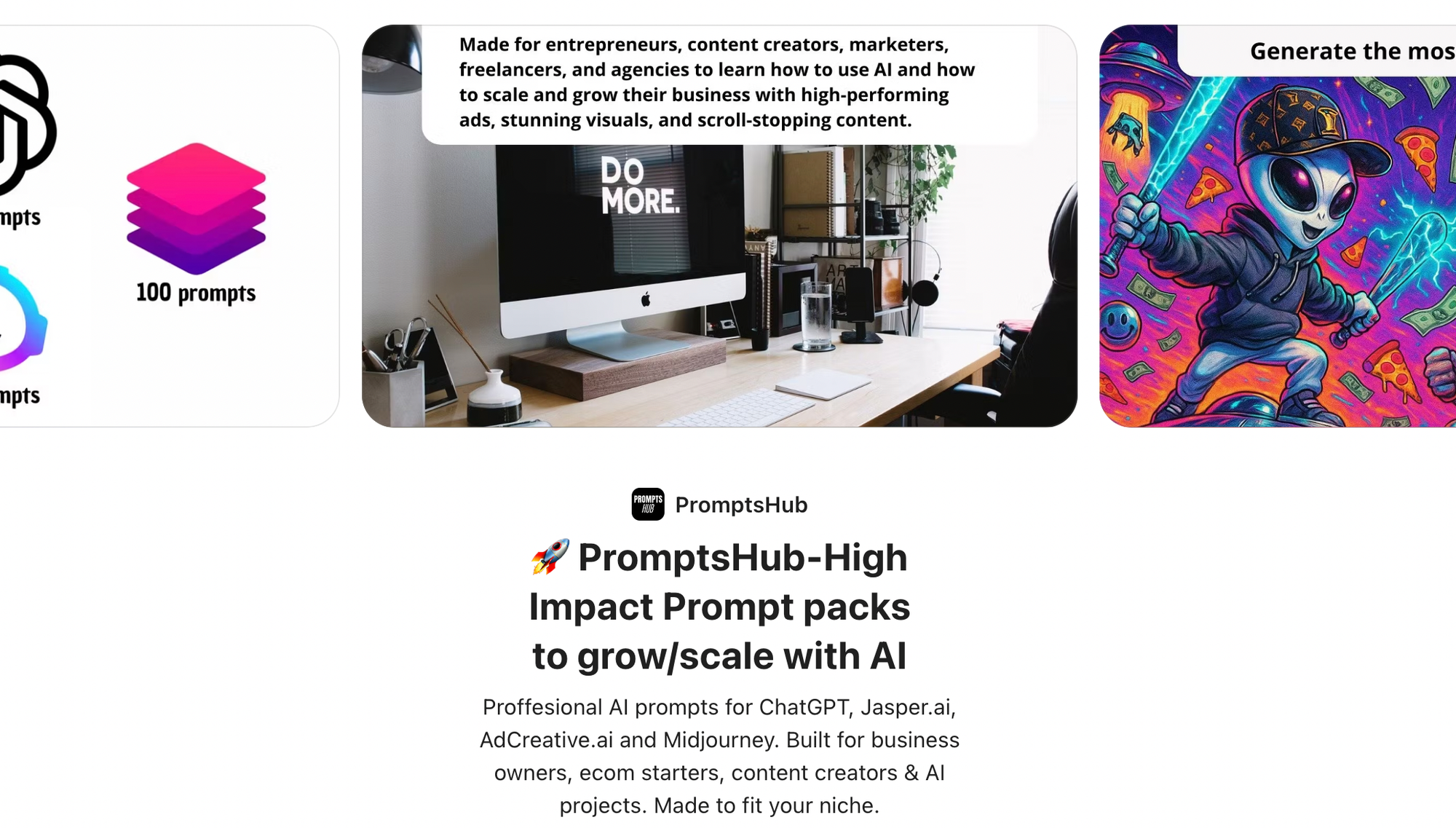
If you know your way around AI, then you can create AI prompt packs to help others make the most of AI systems.
AI prompt packs are curated collections of ready-to-use prompts for tools like ChatGPT, Claude, and DeepSeek. These prompts will be used by everyone from educators to developers, freelancers to writers, marketers, and designers.
You can create different prompts for different industry niches to really maximize the earning potential here.
How easy is it? Easy - all it takes is a little trial and error with prompts
How much does it cost to start? From $0
How much can you earn? Prompt packs sell for anywhere from $5 to $100
105. Gamified habit trackers
With so much of our time spent online and at work, many of us are trying to build healthier habits.
But, it's hard - we have to juggle work, seeing friends, eating well, moving our bodies - how do we stay on top of it all?
That's where gamified habit trackers come in. These tools make habit-building feel fun and achievable, whether someone’s aiming to get fitter, be more productive, or simply stay organized.
From printable worksheets with built-in rewards to apps with mini-games, your habit tracker can turn progress into a game. This is an easy way to generate passive income, but if you want something more active, why not create a productivity community where you track each other's habits?
How easy is it? Depends on what you choose to create - a Canva worksheet is simple, an app is a little more complex, and a community is a simple product that requires continual work
How much does it cost to start? From $0 (again, depends on what you create)
How much can you earn? $5-50 per sale for worksheets, $5-25 per membership (recurring monthly) for an app or community membership
106. Virtual co-working sessions
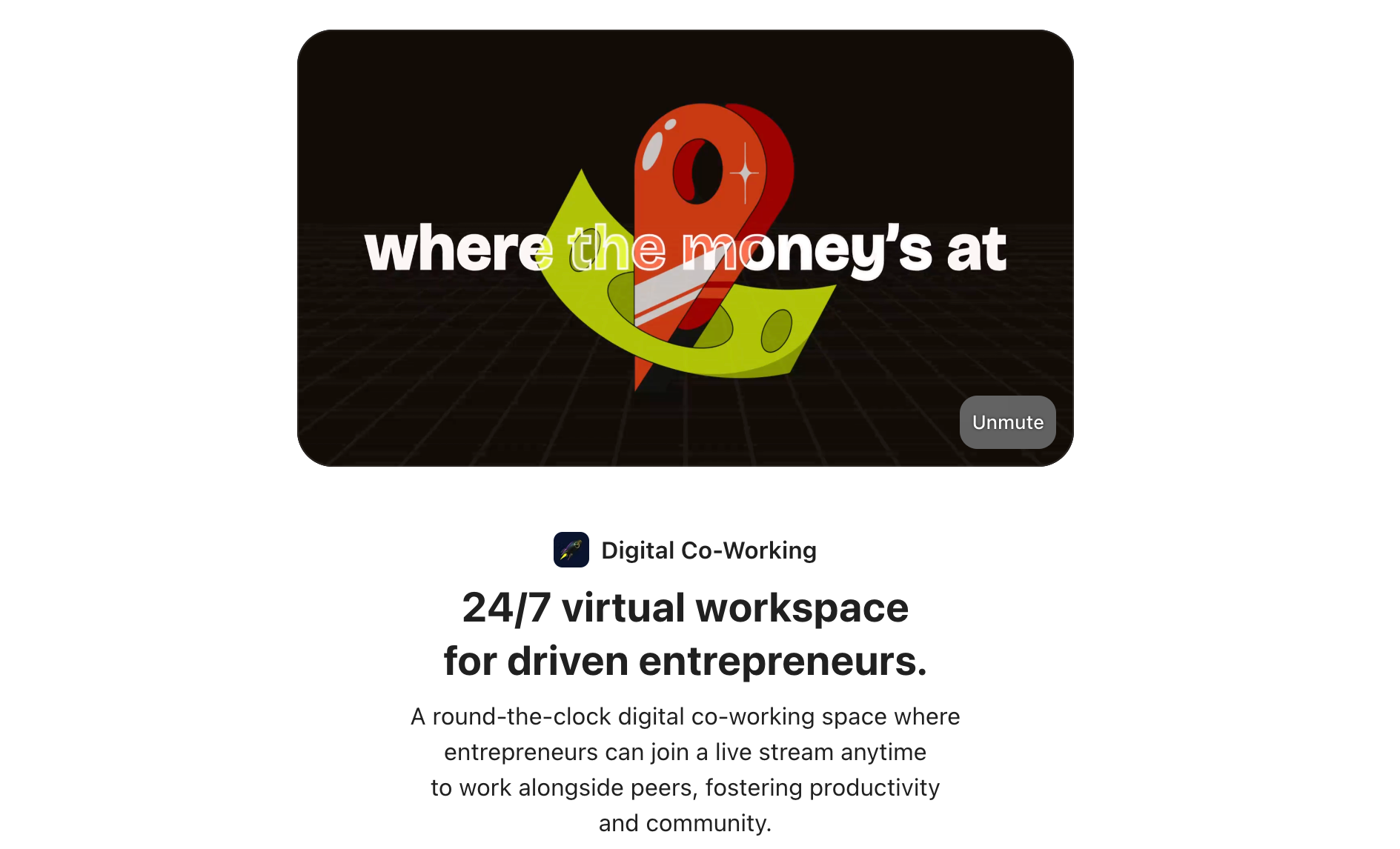
Virtual co-working are perfect for creators, freelancers, or entrepreneurs who want to boost focus and accountability in an online setting. Create a whop and host these sessions with the livestreaming feature help people stay productive.
You can offer these as part of a paid membership or sell access in bundles or as a subscription.
To make even more money, market your co-working sessions to a specific niche - say, co-working for writers, ADHD entrepreneurs, or startup founders. Add in a bit of structure (like goal setting or end-of-session check-ins) and you're sitting on a gold mine.
How easy is it? Medium: easy to host, requires consistent scheduling
How much does it cost to start? $0 if you already have a webcam and use Whop
How much can you earn? Moderate to high depending on your audience and niche
107. Brand voice or tone-of-voice guides
Brand voicing guides are powerful tools for business owners who want consistent, scroll-stopping content across every platform. These documents help a brand carve out their own voice, whether that’s cheeky and casual or polished and professional.
You can create custom guides for clients or sell templates they can fill in themselves. This type of product is ideal for copywriters, marketers, and brand strategists looking to make money with their skills.
How easy is it? Easy: especially if you already offer brand strategy or copywriting
How much does it cost to start? Nothing but your time
How much can you earn? Medium: custom guides can fetch $$$, and templates sell passively
108. Digital learning kits for kids
You can create engaging digital kits that combine printables, audio, and simple interactive elements, designed to help kids learn through sight, sound, and hands-on activities.
Perfect for parents, homeschoolers, and educators seeking dynamic and engaging educational tools. Plus, so long as you have a good grasp of elementary school knowledge, there’s no real special skills or expertise required.
How easy is it? Easy, but requires basic design skills, simple recording equipment, or interactive PDF tools.
How much does it cost to start? Low, mainly software subscriptions (if needed), and a microphone or smartphone for audio.
How much can you earn? Moderate to high, depending on your niche and marketing. Some kits sell for $10 to $ 50 or more each.
109. Customizable media & business kit templates
Sell customizable kits designed to help creators, startups, and small businesses present themselves professionally.
Think press kits for influencers and musicians, brand kits for startups, financing pitch decks, one-pagers for investors, and media sheets for speakers or podcasters. These can be built in Canva, Notion, or Google Slides and sold as editable files.
Many entrepreneurs don’t have the time or skills to make these from scratch, so sleek, pre-designed templates are a win.
Package them up, market them on social media, and sell through a digital marketplace like Whop.
How easy is it? Easy, just need design skills and a template platform.
How much does it cost to start? Low using free or low-cost tools like Canva.
How much can you earn? $20-$100+ per kit or bundle.
110. Done-for-you Notion workspaces
Is your workspace organization often the envy of your office coworkers?
Sounds like you’re the right person to build and sell complete Notion setups for specific use cases — think content planning, freelance business management, habit tracking, or personal finance dashboards.
People love Notion but hate setting it up, so if you're good at making things look clean, you're in. These templates are perfect for creators, freelancers, students, or anyone trying to get their life together.
How easy is it? Easy, especially if you already know and use Notion.
How much does it cost to start? Very low, just time and a Notion account.
How much can you earn? $10-$100 per workspace, depending on complexity.
Hopefully, your creative juices are well and truly flowing by this point and you’ve got lots of digital product ideas buzzing around your head.
If you're ready to start right away, click the button below to start selling with Whop now.
Otherwise, keep reading for more tips on creating and selling digital products.
How to create digital products

Here’s how to start selling digital products.
1. Identify your audience
Determine who you want to create a digital product for. It helps if you know an audience well (or, even better, are the audience). For example, if you’re a parent of young children, you might decide to create digital products for parents or children based on what you already know.
Try to be specific with your audience too — instead of choosing “women”, dig deeper and choose a segment like “20-25-year-old women who enjoy yoga but don’t have the money or are too busy to attend weekly in-person classes.”
Here are some questions you can think about when determining your audience:
- How old are they?
- Where do they live?
- What are their interests?
- What problems do they face in day-to-day life?
- What are their biggest challenges?
- Why might they need a digital product?
Not only will this help you market your digital products to the right people, but it’ll ensure you’re creating products that they really want and need.
What is a target persona and how do you create one?
2. Brainstorm product ideas
Now you know who you want to create digital products for, start thinking about what you’re going to create for them. While reading this list, did anything jump out at you? It’s always best to choose a format you feel most comfortable with. For example, if you don’t enjoy being in front of the camera, don’t make a video course or film a masterclass.
But it’s not just about you. It’s also about your target audience and what they want.
When you identify your audience, you should come up with some challenges and interests they have. You can use this information to brainstorm what kind of products might suit their needs. For example, 20-25-year-old women who are too busy to attend in-person yoga classes might relish an online membership with weekly online classes.
Check out which digital products are in demand.
3. Create your digital product
This is where the fun starts. You’ve got your audience and you’ve got an idea, which means it’s time to create your digital product. If it’s a one-off product, like a recorded masterclass or an app, it helps to map out your production plan. Do you need any help? What research do you need to do beforehand?
Then, make use of online tools to help make your product look as professional as possible. Here are some tools that might come in handy:
- Canva
- Creative Market
- Loom
- Notion
This is also a good opportunity to think about where your digital product is going to live. Do you need to create a standalone website? Or can you harness make an existing platform, like Creative Market, Etsy, or Whop?
- How to make a digital product in 6 easy steps
- How to become a digital creator and unlock your earning potential
4. Promote your digital product
Once you’ve made your digital product and it’s ready to be released into the wild, think about how you’re going to spread the word. It helps to have an existing platform you can market on straight away, but most creators start from square one with no followers and no audience.
It’s much easier to choose one or two places to promote your product instead of spreading yourself thin across every platform you can think of, so decide where you want to spend your time (and, more importantly, where your target audience spends their time). For example, you might market your online yoga classes for 20-25-year-old women on TikTok and Instagram, as those platforms are most popular among that age group.
Try out a few platforms and see what works best:
- Share Instagram Reels and Stories with a link to your product
- Create a free lead magnet to build your email list
- Share your digital product in relevant Facebook groups
- Run paid ads on social media
- Upload your digital product to existing, searchable marketplaces
- Build a website and write content to attract people searching for products like yours
Discover the best digital product marketing strategies to grow your sales
5. Monitor and learn from your results
The best way to make the best digital product is through trial and error and learning from your mistakes.
You won’t make millions on your first day, but if you get feedback from customers and tweak your offering to something much-needed and valued, you can make a decent chunk of passive income over time (or a full-time income further down the line).
Where to sell digital products
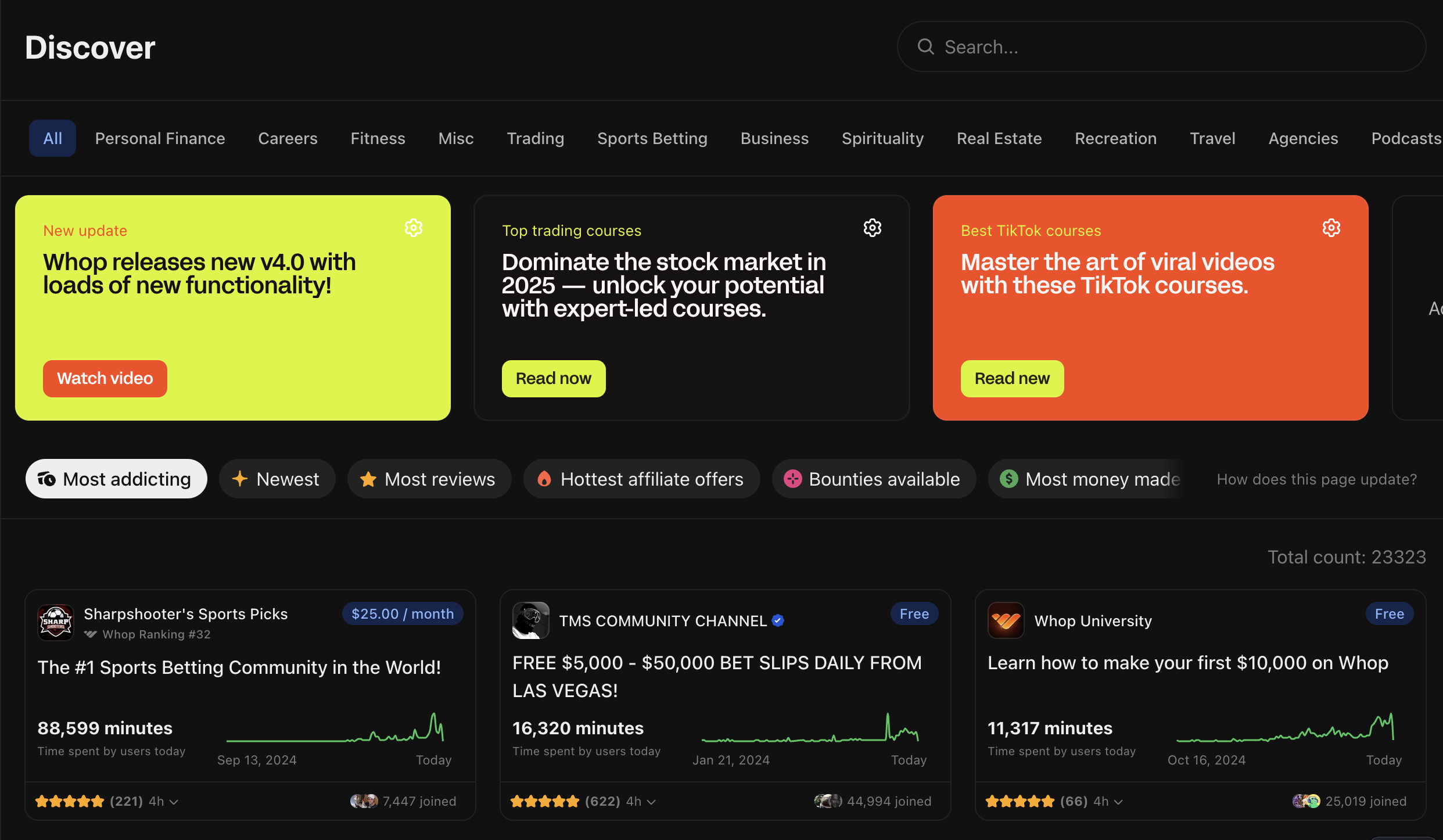
Once you’re ready to launch your digital product, you need to decide where to sell it. There’s a wealth of platforms designed for selling digital products, including Whop. You can find almost every type of digital product there, from ebooks and templates to memberships, online courses and masterclasses.
Ready to get started? It’s really easy to sell your digital products on Whop:
- Create an account on Whop.com
- Create your own whop (this is a hub for your digital products and community)
- Add apps to your whop for the products that you want to sell (you can add as many or few as you like)
- Manage your whop products by setting up access settings (private, public, free, or paid)
- Go through the handy launch checklist and voila! Your digital product is ready to go out into the world
Learn how to create your whop with this step-by-step guide
How to market digital products
The hardest part of selling a digital product isn’t coming up with digital product ideas or even creating your product — it’s finding people to buy it. If you don’t already have a huge audience waiting with bated breath, you’ll need to promote your digital product in the right places to the right people.
Here are some ways you can start marketing your digital product:
- Run paid ads: get eyeballs on your digital product quickly by running ad campaigns on social media.
- Use Content Rewards: Use Whop to create content rewards - a system with which you set your budget, outline what you want, and get creators to make UGC or clip your exsiting contnt.
- Partner with affiliates: bring industry influencers (small or big) on board to promote your product to their existing audiences in exchange for a slice of the sale price. Affiliate marketing is a great way to get more customers.
- Collect testimonials: gather social proof in the form of reviews and testimonials to share on social media and your product landing page.
- Optimize your website: attract shoppers from the search results by implementing relevant keywords and on-page SEO tactics.
- Use social media: set up social media accounts on your favorite platforms and create engaging content to grow your audience — don’t forget to direct people to your digital product in the captions and your bio.
- Film YouTube videos: create walkthroughs or tutorials that complement your digital product and share them on YouTube.
- Start an email newsletter: nurture connections by encouraging people to join your email list and sharing thoughtful, relevant content with them.
- Sell on an existing marketplace: Whop, Amazon, Etsy - these are all successful digital marketplaces where potential customers can easily find your product by browsing through categories.
Start selling digital products with Whop
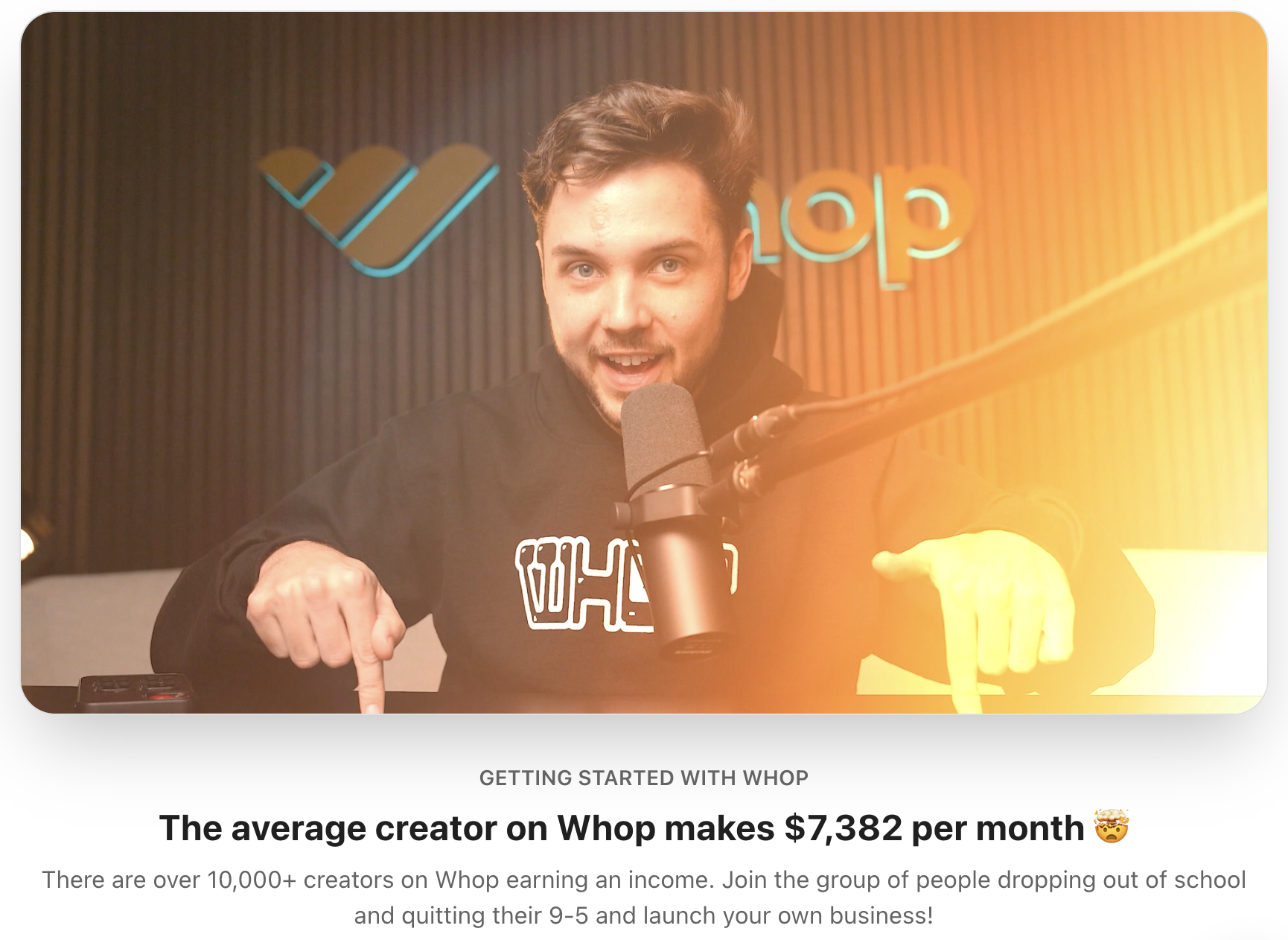
Digital products aren’t going anywhere. More people are choosing to buy digital versions of traditional media and jumping on the bandwagon could see you earning a decent chunk of passive income with relatively little effort.
The average creator on Whop makes over $7,300 a month selling digital products and services. That's over $1000 more than the average monthly income (as per Bureau of Labour and Statistics).
So if you want to start earning money with digital products, then Whop is the place to be.
Digital product FAQs
What are digital products?
A digital product is a product that predominantly lives online. Unlike physical products, you can’t hold it in your hands. Instead, you “experience” it via your web browser or device.
We’re talking about things like ebooks, downloadable guides, paid communities and apps — intangible products that are created, distributed, and consumed in a digital environment.
Many digital products take inspiration from physical products, like ebooks versus actual books, or digital planners versus real planners that you write in with a good old-fashioned pen.
Why sell digital products?
The speedy evolution of technology would have us believe that we’re not too far off from living our lives online. But keeping up with changing consumer habits and the advanced state of the digital world aren’t the only benefits of selling digital products.
Sell over and over again
Unlike physical products, you can never sell out of digital products. Where you’d have to stay on top of inventory and keep stock levels high in the physical world, the digital world is different. Once you’ve created a digital product, you can sell it over and over again without needing to order more or wrestle with complex supply chains.
Generate passive income
We’d all like to make money while sitting on a beach sipping mojitos. The reality is that you can be a digital nomad with digital products. It takes time to build consistent sales, but once you’ve put in the upfront work and set up your sales system, you can sit back and enjoy the money that comes in on autopilot.
Scale quickly and easily
Digital products require no physical storage space. You don’t need to ramp up manufacturing to meet growing demand. In fact, it’s the same amount of work to sell one digital product as it is to sell 1,000.
Low startup and running costs
There’s a digital product for every budget, but most don’t require a hefty upfront investment to get started. Instead, you can choose a product that fits your budget — the only expense is WiFi, a device to create on, and your time.
And very little changes when you grow. Costs are still limited to any tools you need to manage sales and an internet connection.
Freedom and flexibility
Who doesn’t want more freedom? Fancy hopping on a flight to Rome on a random Wednesday afternoon? Want to take an ad-hoc morning off to go swimming with the kids?
These dreams are closer than you think when you sell digital products. With passive income trickling in, you can spend more time doing the things you love.
Reach more people
Digital products are often a lot more accessible both in pricing and in location. While you might be limited in who you can sell a physical product or service to, the possibilities are endless with digital products.
How much can you make selling digital products?
Different types of digital products to sell
The great thing about the internet is that pretty much anything is possible - there’s no limit to the creativity out there.
That being said, certain digital products are more common than others:
- Ebooks and downloadables: Including digital versions of fictional books, practical guides, and downloadable checklists, workbooks, and planners. Basically, anything you can download and read or print out.
- Software: Widgets, plugins, website templates, apps, and tools all make great digital products. There’s some upfront effort involved, but once you’ve designed and made a piece of software, you can sell it countless times.
- Digital media: We’re talking about things like paid podcasts, newsletters, stock photography, stock video, and magazine subscriptions. You can monetize these things in different ways. For example, you can ask customers to pay a one-off fee, you can offer a subscription, or you can sell ads in your chosen media type.
- Online courses and masterclasses: Create a course, tutorial video, or masterclass that walks people through a specific solution or task.
- Memberships and communities: Memberships and online communities bring like-minded people together in exchange for a set monthly fee. A lot of the time, paid members get exclusive content.
Other places to create and sell digital products
Ultimately, the platform you choose to create your digital product will depend on the type of product you’re selling, but here are some other popular places to sell digital products:
Digital product download sites
Best for: Ebooks, guides, planners, calendars, printables, and trackers.
Sites to use: Whop, Gumroad, Lemon Squeezy, Amazon, Etsy.
App stores and marketplaces
Best for: Apps, software, tools, and video games.
Sites to use: Whop, Apple Store, Shopify App Store, Google Play.
Digital community platforms
Best for: Memberships, online communities, subscriptions.
Sites to use: Whop, Slack, Circle.
Website template marketplaces
Best for: Website templates, Photoshop brushes.
Sites to use: ThemeForest, Creative Market, Elementor.
Online course platforms
Best for: Online courses, content libraries, email courses, video courses.
Sites to use: Whop, Podia, Thinkific, Teachable.
Stock photo marketplaces
Best for: Stock photos, stock videos.
Sites to use: Shutterstock, Unsplash.
Ecommerce platforms
Best for: Independently selling digital products, digital artwork, printables, and courses.
Sites to use: Whop, WooCommerce, Squarespace
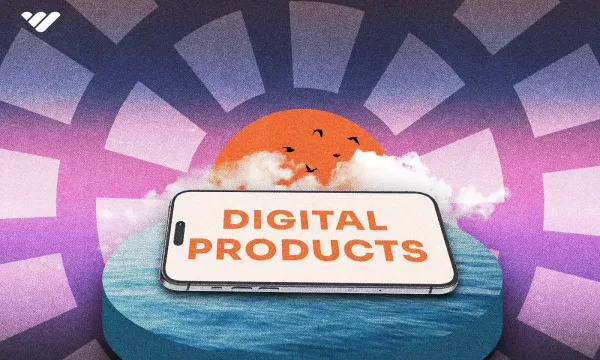

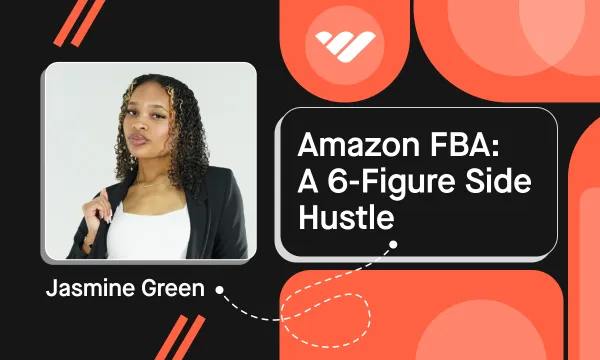
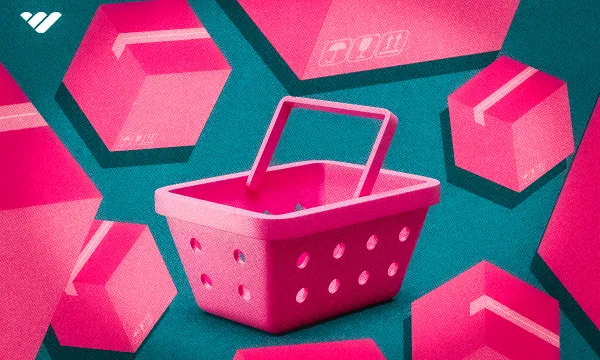
![What is digital dropshipping? [2025]](/blog/content/images/size/w600/2024/09/What-is-Digital-Dropshipping-and-How-To-Get-Started.webp)
![Top 16 best ecommerce Discord servers [May 2025]](/blog/content/images/size/w600/2023/09/ecommerce-groups.webp)